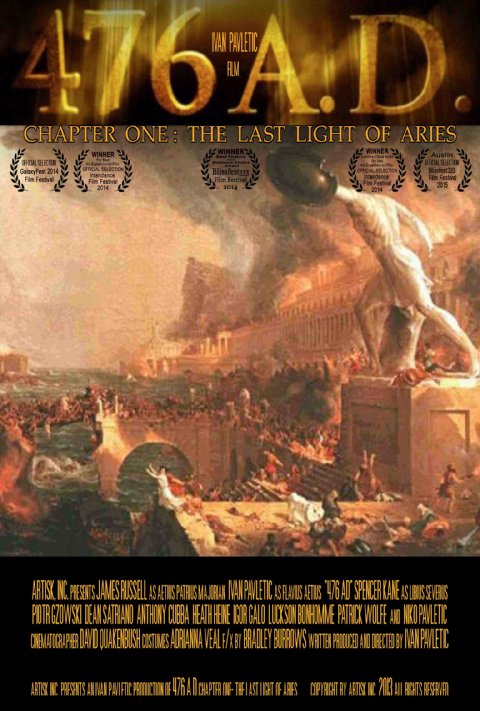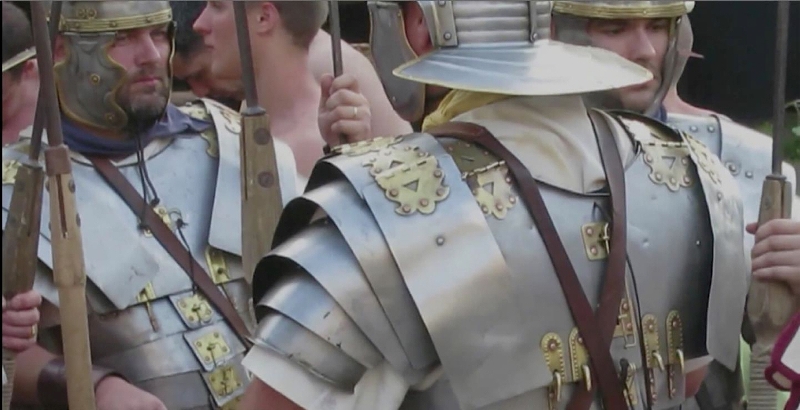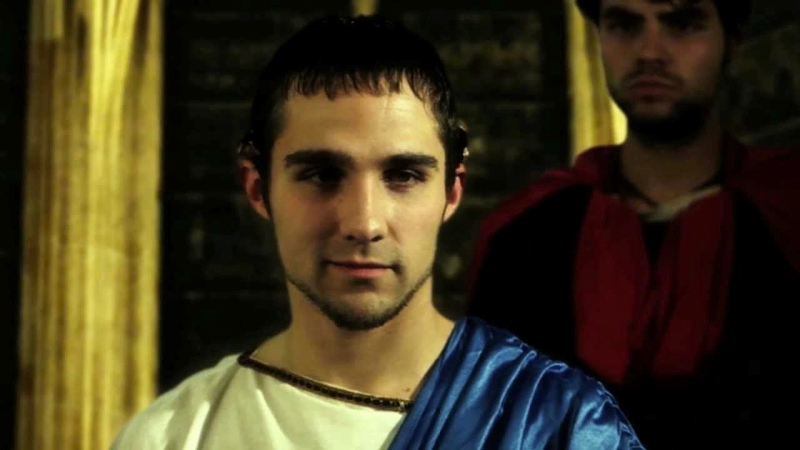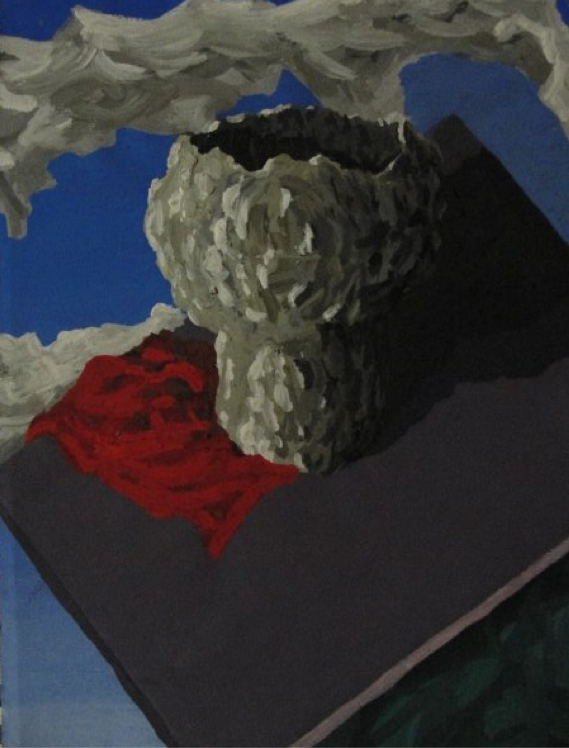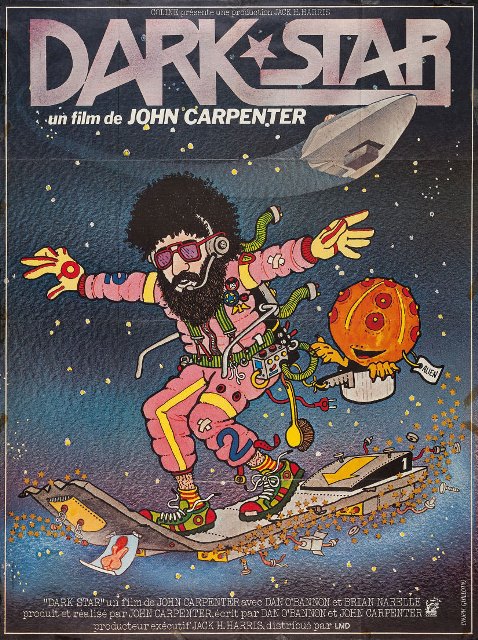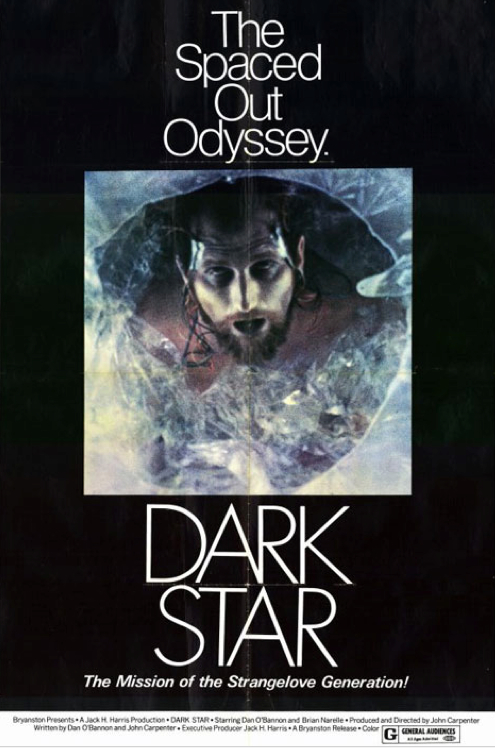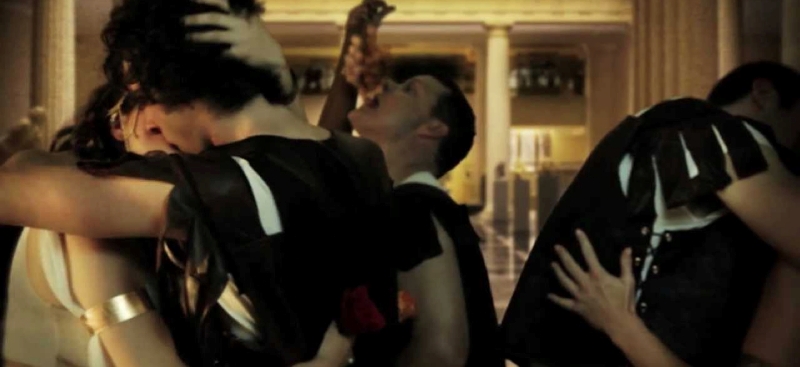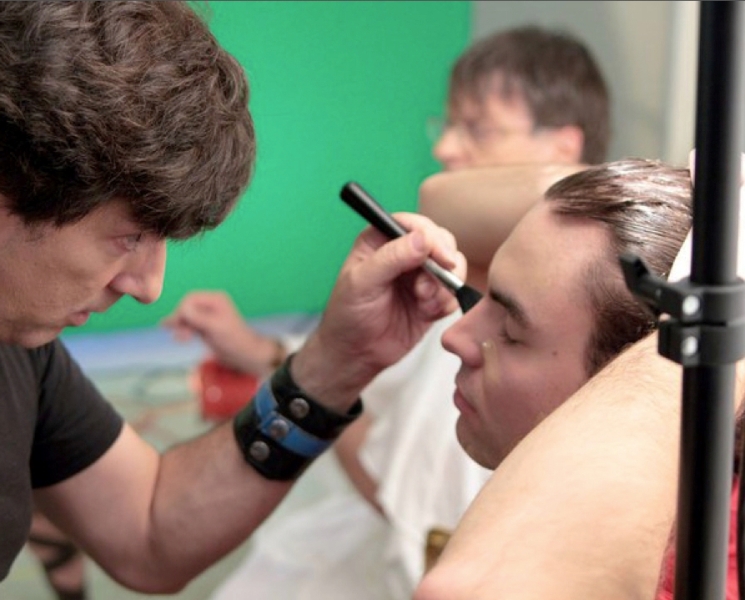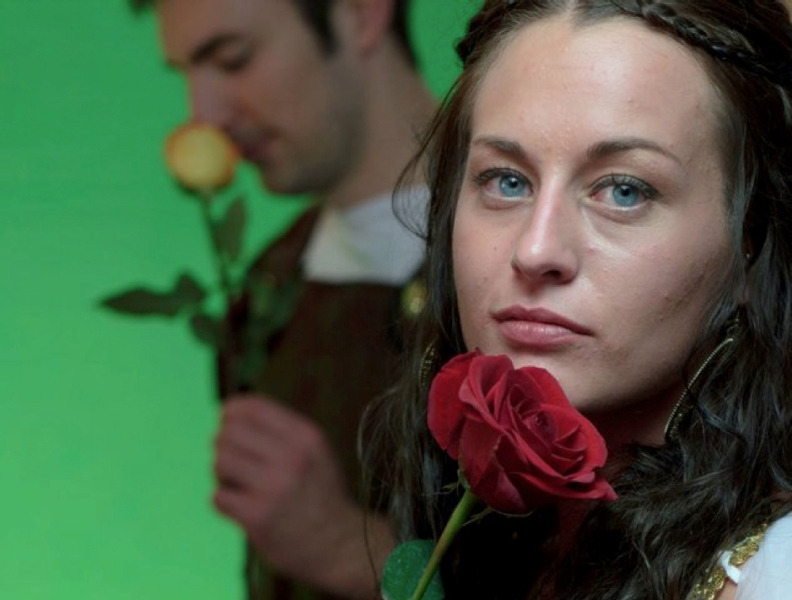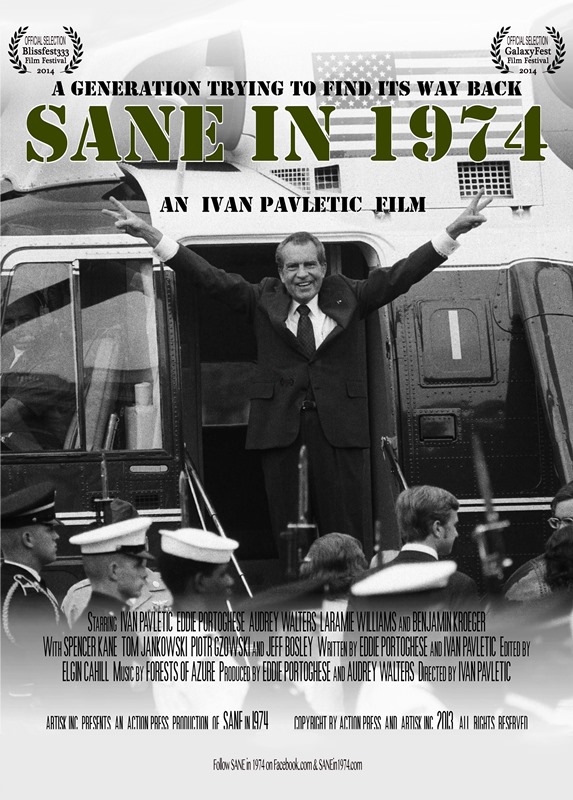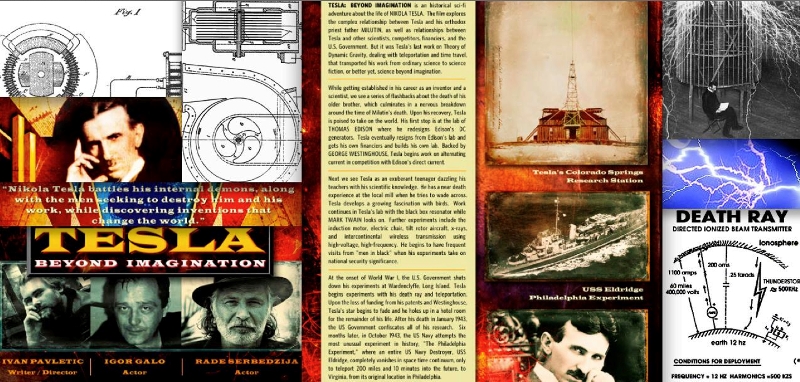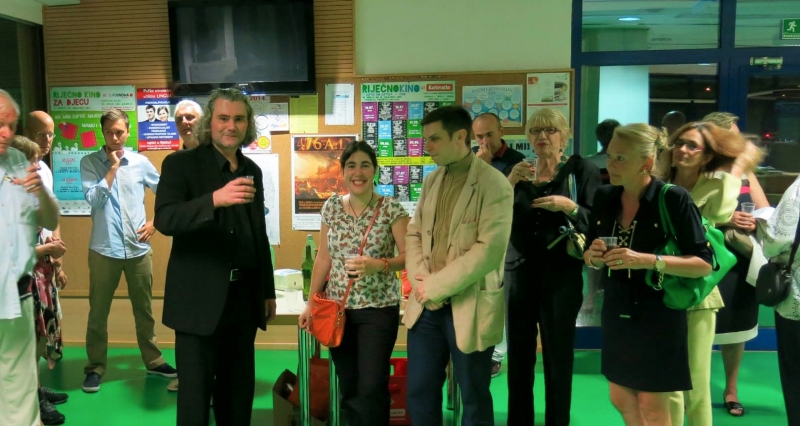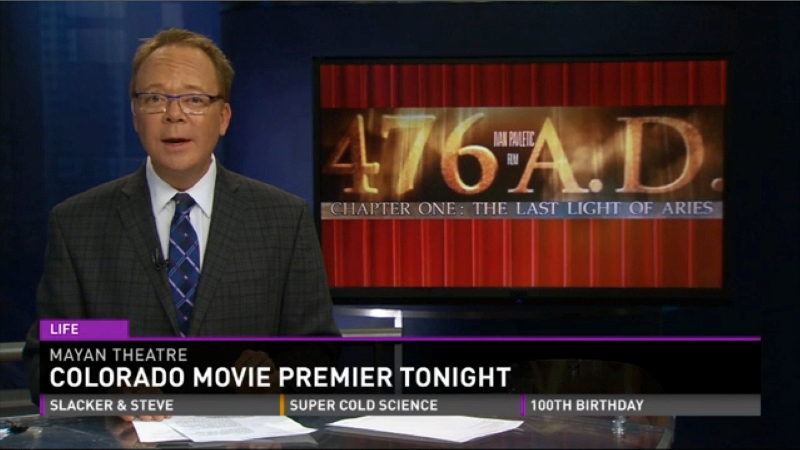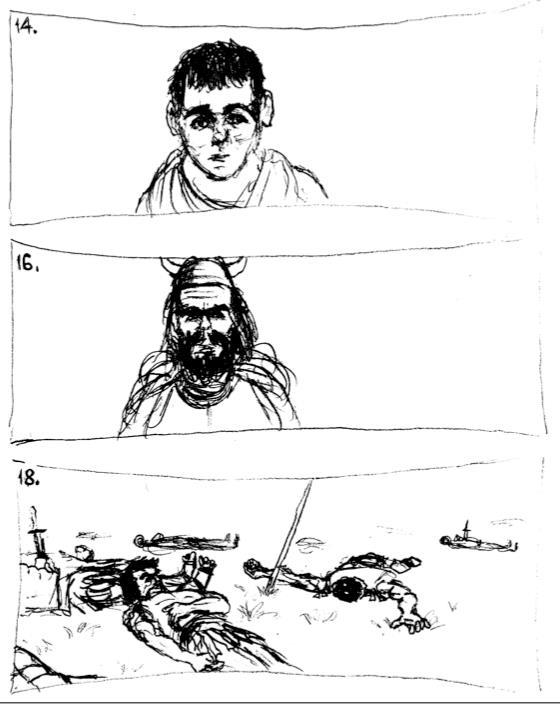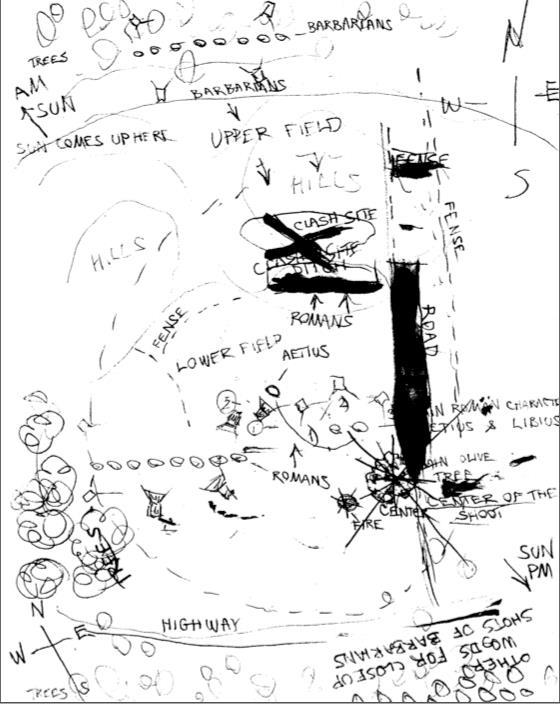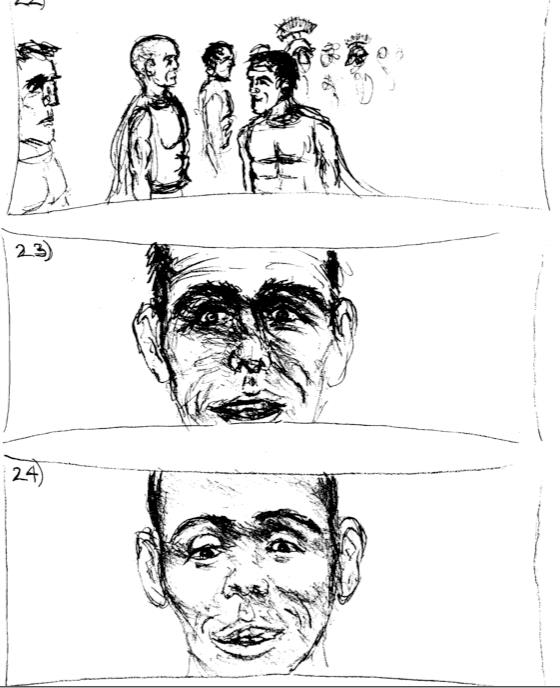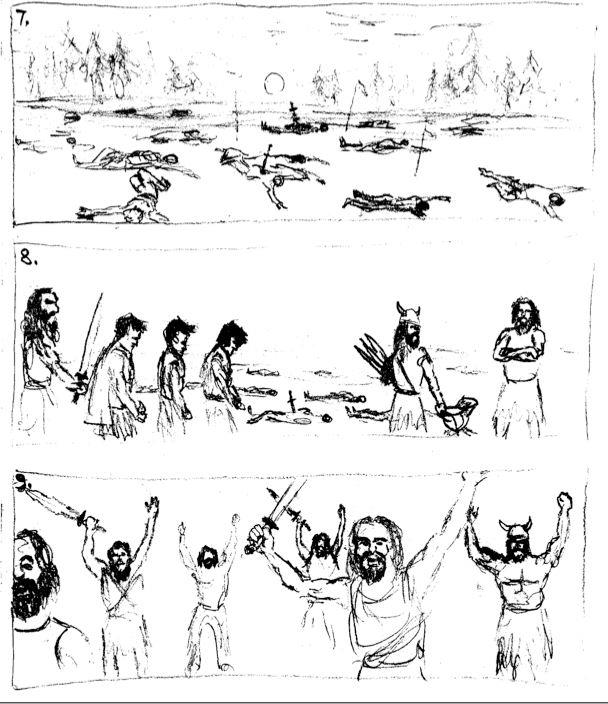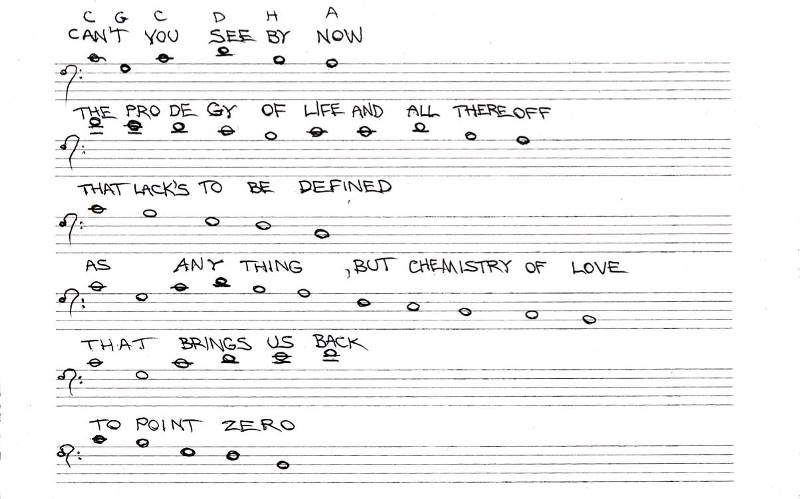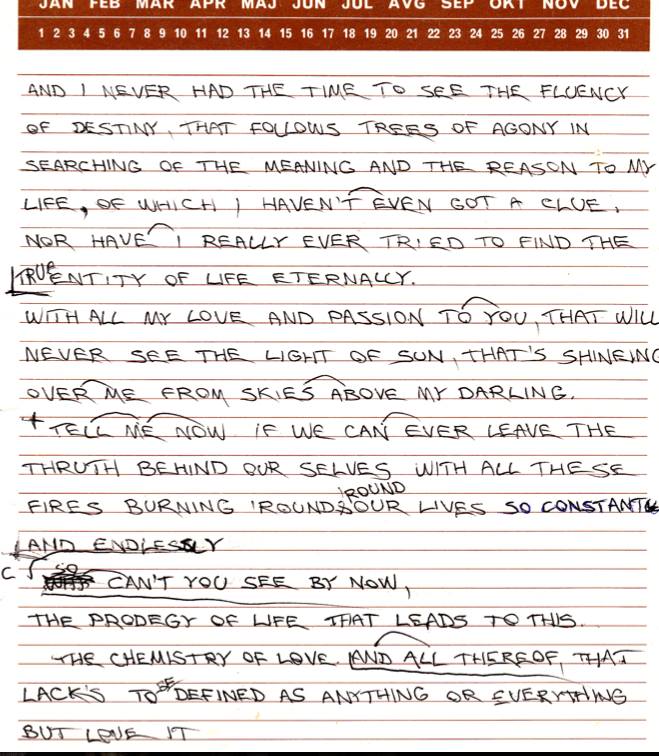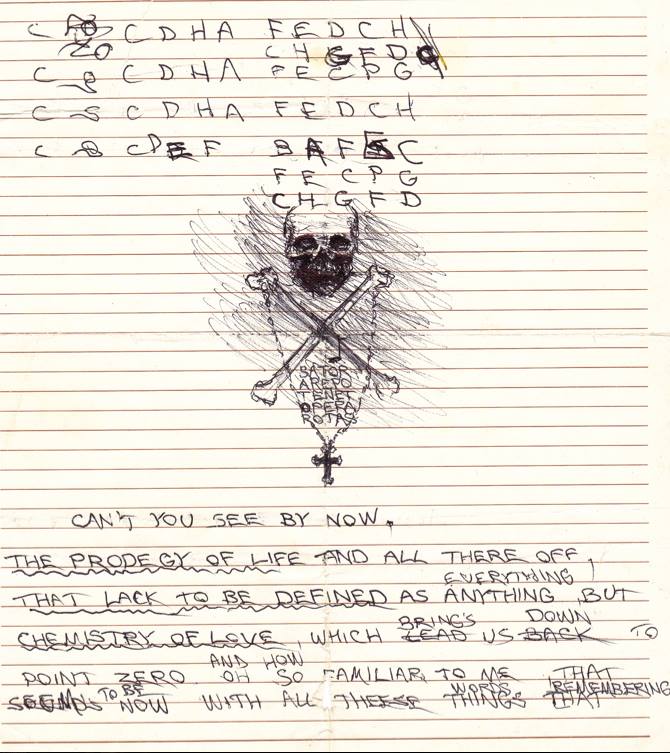 | We recently sat down to talk with Croatian-American filmmaker and painter, Ivan Pavletic regarding the release of his historical epic 476 A.D. Chapter One: The Last Light of Aries is available on Amazon.com. The film tells the story of General Flavius Aëtius' Last Victorious Campaign against Attila the Hun, which brought order back to the Roman Empire, with General Aëtius' increasing political power and popularity as "The True Savior of Rome", he becomes a threat to Caesar Valeninian III and the Senate of Rome. |
| "WHAT A MAN CAN DO TO ANOTHER MAN, NO BEAST WILL EVER DO" -Ivan Pavletic AKA General Flavius Aëtius For 1,000 years the Roman Empire was a political and cultural powerhouse, and it's legacy is felt even today. It was not meant to last, and Rome eventually began to decline. Enemies inside and outside of the Roman Empire began to circle like sharks, ending the once great empire and heralding the start of the Dark Ages. The film 476 A.D. Chapter One: The Last Light of Aries, takes viewers into the heart of Rome’s decline and fall. It is a treat for fans of the Roman Empire and for those looking for an alternative to popular movies and now it is available in time for the holidays on Amazon.com! We recently sat down to talk with Ivan Pavletic, the film's director to talk about him, the film and what other projects he has on the horizon among other things. We would like to thank Ivan for taking the time to speak with us and for providing an exclusive behind-the-scenes look at 476 A.D. Chapter One: The Last Light of Aries!
476 A.D Chapter One: The Last Light of Aries from Bondi Rights Management on Vimeo.
After General Flavius Aëtius frees the Roman Empire from the clutches of Attila the Hun, Rome is once again secure. However, this assurance is short-lived, as the growing power of General Flavius becomes a threat to the Senate and the Emperor of Rome, hence Flavius becomes a victim of assassination by the political hierarchy.
Q & A with Director Ivan Pavletic 1. Tell us a little about yourself, and your background. Well, my name is Ivan Pavletic, I'm a painter and a filmmaker, and my production company is Artisk, Inc. I am 41 years old, originally from Croatia, I have lived in Colorado, USA, on, and off since 1996, after the Independence War in Croatia ended, and finally situated my permanent residency in Denver. I have been in visual arts pretty much my entire life. Attended the school of applied fine arts in Zagreb, Croatia, as well as other schools for fine arts and history. A decade later in the U.S. I went to Colorado Film School, and Regis University, where I studied writing and directing. 2. What do you believe is the most important element that you try to bring across through your work? I always try to do something new, something that hasn't been done the same as before. I believe that any progress is through something being new and original, otherwise, if we follow the same identical formula over and over again, we enter a form of stagnantion, where artform sits in a hibernation mode, from which no progress can come out of. Our lives are relatively short, and it is that which we leave through our creativity and creation, that lasts as an echo after we leave this earth. Other then just expressing your self through media such as film, I believe it is also very crucial to leave a message that truly matters, and can actually make a difference in some way or the other. I remember that in the midst of the darkness of the Croatian Independence War (1991-95) in which I found my self as a confused and freaked out 17 year old kid, while ducking bullets and shrapnel, and building bomb shelters in my hometown of Karlovac, my deep passion for bringing what I considered important stories onto film, started to be truly born. "My first serious job might have been as a stuntman." 3. What was your first job as a filmmaker, and when did you discover you wanted to be a filmmaker? In the previous life, or better yet two lives ago, hahaha. My first job, well, this could be relative, as I mentioned earlier, my first experiences on professional film sets were already as a 10 year old kid. I have been in the field of film, ever since I was a little kid, when I first found my self as a child extra, on the set of Jackie Chan's "Armour of God". Which was being shot between my hometown area of Karlovac, and Zagreb, Croatia. Seeing (then) the young Jackie Chan repeating the identical move, over and over again for a shot, woke something up in me, that made me want to get into this business. Then there were other big Hollywood productions being filmed around my hometown, such as the sequel to "Dirty Dozen" with Telly Svalas, whom I remember calling everybody on the set "Baby". In the next couple of years, I eventually got my hands on a video camera, and ever since then I would be filming stories, writing, directing, and acting as well. Right before the hostilities, and the War in Croatia started, there were quite a few big productions being shot in the former Yugoslavia, and interestingly enough, primarily around the four rivers of my hometown of Karlovac area. There was a US Network TV series "War and Remembrance", with the legends such as Robert Mitchum, where my hometown of Karlovac played both WWII Warsaw, and Berlin. It was the first time as a 14 year old dreamer, where other then being only an extra, I also had a chance of working and actually learning, by helping out as a grip behind the camera, and actually seeing the professionals working on the big 35mm Arriflex cameras. Seeing the whole huge Arri HMI lights being used, and for the first time being part of the whole process, was beyond anything I could have imagined before. Also note, that this was still the former Yugoslavia in the late 1980's, and not Los Angeles, hence the Unions didn't quite matter there. Paralelly, at the same time, there was another Yugoslavian-American co-production being shot a few kilometers away, on the river Korana, where I used to swim all the time. It was Rajko Grlic's "That Summer of White Roses / Djavolji rat", where I remember another legend Rod Steiger being pissed all the time, saying how he was missing his wife, and wanting to to go home. All those experiences, and seeing the masters at work, able to repeat the psycho-physical motion over and over again, definitively built my passion for this work. I started shooting short films as early as a 11 year old kid, as soon as I could get my hands on the early VHS cameras. The whole nine yards, writing the story, directing it, and gathering the actual big crew of other kids, to actually shoot it and put it together. Also, about 1994-95, by the end of the war in Croatia, I created a short psychedelic experimental film, that could be considered sort of a prequel to 476 A.D. by the name of "Age of Pisces" where as a music video/documentary I used all my dark experiences and frustrations from the war, by trying to represent the last 2000 years in one story. Which I named my sequel "476 A.D. Chapter Two: The Dawning of the Age of Pisces". However, in the more "serious" adult life of filmmaking, perhaps, my first serious job might have been as a stuntman. Even with a pause of some 5 years during the war, through those years, on and off, I've been acting in all kinds of productions, videos, commercials, TV series, and anything I could get my hands on. As well as working as a stuntman on Hollywood productions, such as Titus (1999), where I remember seeing Anthony Hopkins sitting every day at the fisherman's bar behind the Arena in Pula, Croatia, and reading his daily newspaper, while tourists around him weren't aware if it was really him, or just someone who looked like him. There were also other big productions such as Le Femme Musketeer (2004 with Michael York), and other Croatian TV series, such as the first Croatian telenovela "Villa Maria". and many other German, and other European various TV film productions. Ever since I can remember, I have been recording my visual experience, either on paper, canvas, or film. Visual expression has been a great passion in my life, and through film I can bring a different reality to people, therefore not only bring my imagination to them, but if possible, try to help them open theirs. I believe that one's expression of life is the most important task in an artist's life. I remember thinking to my self, that despite working on the big sets and getting to meet big acting legends, I really loved anything that is of one's personal substantial artistic creativity. Anything that can leave some kind of a mark on the future, coming from one's own heart and mind, is what really matters. That to me was, and still is, perhaps the most important element in what ever you do. So because I've been in the field of arts, pretty much my entire life, as I've been drawing and painting ever since I could walk and hold a pencil, I felt I had to go back to school to further my education in the field of writing and directing.
On the set of 476 A.D. 4. What aspect of film making do you like the best? Aspect of film making that I like the best, I would have to say is directing. Eventhough acting is a great passion of mine, as sometimes I feel that I know exactly how to depict a certain emotion on the screen, it still comes down to that visionary view of the scene. I just have this urge to envision the entire film sequence in my head, to the slightest detail, including the actual music, that gives the necessary atmosphere and emotion, and create the entire story all together. Many in the film industry do not particularly like this approach, as the whole "Auteur" element of a filmmaker is looked upon as something problematic in the overall creation in the motion picture, hence many times it is shunned upon. Film is a mutual effort by many people and talents involved, therefore, it is not particularly liked when the creator/director's personal influence has the overall artistic control. This is something that might be one of my shortages, as I do like to do most of the elements in the filmmaking process, which is not always the best thing. I have learned through time, to simply not interfere with my cinematographers, as every cinematographer on the set likes his vision also to be respected as such. So, as I love to sketch and draw my own Storyboards, through my drawing I can more clearly relate the actual visual picture to my cinematographer, and through the drawing, show how that vision should look on the big screen. Film is a very complicated artform I think, as the creator is subject to a very subjective judgement by the audience, yet at the same time, the director is the one that must carry the burden of the final product on his or her shoulders. As the saying goes, "A thousand eyes, a thousand opinions", and even though every one of those opinions is important, the creator behind the vision, must stay true to him self, as it is really that creator's vision that at the end must create something new and original.
Ivan on set early in the morning discussing the filming of the next scene. "I do believe that every film I direct has it's own personal connection" 5. What is your favorite memory of work? My favorite memory of work, I would have to say, is probably this low budget indi monumental undertaking "insanity" of creating the Roman Epic story of 476 A.D. When I take in consideration, not only months of working on these movies, but years of my life that had gone into this mad experiment, it's really hard to compare any other experience in my life. At least, not from a filmmaking stand point. Which of course doesn't mean that in the future I might not be confronted with even bigger obstacles of much higher budgets. However, there is just something specific about this whole low budget Roman story, that I think will always sort of stand out in my life as that one of a kind thing, to which there is just nothing quite like it. Just the obstacles that we as a production unit were able to overcome in next to impossible circumstances and conditions, by shooting this insanity of a film experiment about the Fall of Rome. Then the couple of years of working with my post effects assistant Bradley Burrows, on the pain staking post-production of hundreds of hours of all kinds of footage, and hundreds of various green screen shots, multiplications of characters, rotoscoping, and etc. just makes me wonder, what the hell was I thinking, hahaha. Sometimes you can see who your real friends are, by how much they are capable of withstanding your overly detail oriented perfectionist nature. If that is the case, then my post effects assistant Bradley Burrows was truly there for me through all the possible obstacles. Many filmmakers have stated before that the Roman Empire genre is cursed, to the point that it is nearly impossible to depict it in any real objective way. Hence, I was confronted with one major problem, how to make it work. If masters with budgets of over a hundreds of millions of dollars had failed before, how can a small fish like my self create something so grandiose, yet with such a small budget? How do you do this, yet not stand out as some low budget "film schoolish" look-a-like wannabe? How does one do this, yet that it stays mystique, new, different, and even bizarre in some new film form? How do you make it work, yet that it doesn't come across as pretentious or too artsy? This was, and still is my biggest obstacle in filmmaking. How to create something new, that hasn't quite been used before? Pretty much, since the golden days of Hollywood, with the classics such as, Gone with the Wind (1939), very little has actually changed in the actual basic editing formula. The film process has changed, digitalization of film has changed, the look, digital effects, CGI, that is all different, however, the basic formula of editing which they still teach in film schools, that is still pretty much mostly all the same, even some 80 years later. Of course, with some exceptions of Quentin Tarantino, and many Italian filmmakers of the 1950's-70's. However, the great majority of movies today, even though they might be very well done with huge budgets, they still look, sound, and feel the same. I always say, better a new original risk, that is always at risk to not be accepted, then the old security. Is it in filmmaking, painting, music, or any art form, a new style to me is far more interesting, then a good old secure method. Even if a new style might not function at first, it still is a spark for a whole new dynamic to start, and that to me is something worth a while. At the end of the day, as I consider my self still a beginner in the field of directing, compared to many others, it is really hard to say, what movie that I directed is my favorite. Perhaps, one day when I might have 20 directed feature films under my belt, I might have more to say. I do believe that every film I direct has it's own personal connection, such as the feature film "SANE in 1974", about the disturbed Vietnam veterans coming back home to the problems of the mid 1970's America. Not to mention so many other movies I was involved through some form of production of either as a director, assistant director, or producer. However, one of my favorite stories/films that I wrote and directed, as well as acted in, was a very modest little short film called "Tough Luck". A short story that I wrote many years ago, and just wanted to put on film over a weekend shoot with a few of my friends. That little no budget short film, that we shot some 7 years ago, was the closest to my real life and nature, as it had something of my personal life involved in it. It was a little film about a man's trials and tribulations with gambling addiction, as well as addictions in general, as life's cold realities one faces in the real moment's of truth, dealing with elements of sickness, marriage, and fatherhood. Even though this film was cinematographically made very simple and modest, compared to some other more higher budget and complex productions, I believe there is something in the simplicity of the real truth in life, that when spoken directly from the gut, makes a stronger impact, then through a higher budget grandiosity. Perhaps, the most honest depiction of real life, that through my life's experience, came out in this little short story, just sort of made it my personal little baby, that perhaps one day I would love to remake with a big budget. 6. What Genre do you specialize in? Genre that I might be specializing in, I'd have to say that as a history of arts major, and a history buff all together, it would probably have to be history, especially late Antiquity, and the pre-Medieval period. However, as the most crucial element for me is to speak to the people, it would be, dealing with passionate, and powerful emotional sequences, that in my opinion go beyond the expensive Computer Generated Imagery. 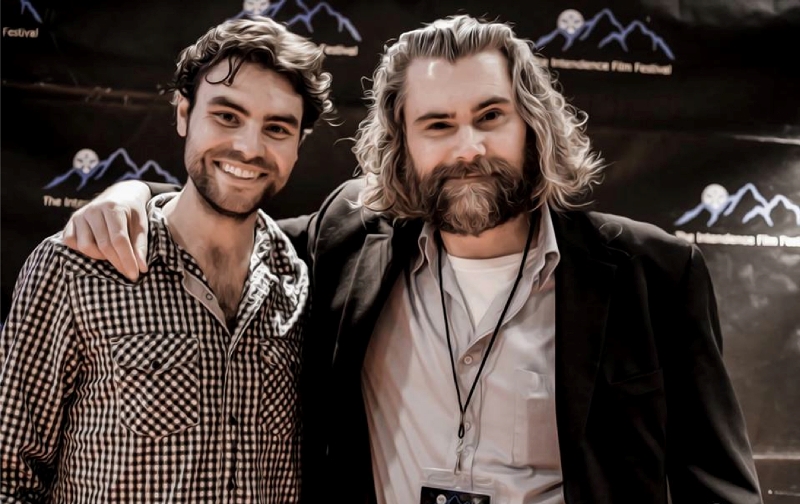 Ivan Pavletic (right) and Spencer Kane (left) who plays Libius Severus in 476 A.D, at the Intendence Film Festival 7. Have you entered your films in any film festivals? I did enter and win at some festivals such as Intendence Film Festival, Blissfest Film Festival, Art Prize in Michigan, and etc. Both for my feature films "476 A.D. Chapter One: The Last Light of Aries, and SANE in 1974, as well as some of my short films like "The Cosmopolitan", however, I have to admit that I haven't really engaged enough in the whole festival protocol, as I probably should. I have been really busy in the last couple of years, with the pre-production, production, and post-production of "476 A.D. Chapter One: The Last Light of Aries", "SANE in 1974", as well as now with the post-production of the sequel "476 A.D. Chapter Two: The Dawning of the Age of Pisces", and not to mention my future "Tesla: Beyond Imagination". I did also show some of my films on many local film showings and festivals in both the US and Europe, such as Mile High movie shows, open screen nights, then the big premiere of "476 A.D. Chapter One: The Last Light of Aries" at the Mayan Theatre in Denver, where we had some very important people in attendance, as well as the Colorado Film Commissioner Donald Zuckerman, who made possible the new Quentin Tarrantino's movie "The Hateful Eight". As well as many showings in Colorado Springs, Manitou Springs, and many other places and local showings. I also had my film "The Cosmopolitan" about modern hidden racism, shown at the Art Prize festival in Grand Rapids, MI, and voted for for the most loved "Date Movie" as it was shown for two weeks in a row, at the oldest and biggest Beer Pub/Restaurant Landmark in Michigan, "Hop Cat". Nevertheless, I have have a confession, in all honesty, I was never really a big fan of film festivals, or any festivals, or such competitions per se, as I never really feel comfortable in such VIP environments. I consider my self an artist first, then a filmmaker, actor, writer, producer, and I never felt comfortable in the whole image ego based celebrity style of film industry. I think that the whole "stardom" of Hollywood type film industry, looses something of that artistic humility, that gives us that necessary originality and magic, that film really is. As my first art has always been and will always be paining and drawing, I think, envision, and live that life as a painter. Even in my movies, I always try to project my vision as sort of a painting, rather then a "product", for I don't consider art a product, but rather an expression made to leave something on. 8. What do you believe are the major turning points and landmarks on the way to success? The major turning points and landmarks on the way to success, at least for me, I would have to say, were the war years in Croatia that shaped me and directed me to where I am today. I think that it was there where my eyes opened in many other different levels, which made me envision projects such as this story of 476 A.D. as well as my next "Tesla: Beyond Imagination", in which I already have Rade Serbedzija attached to play Nikola's father Milutin Tesla, as well as Igor Galo, who played Emperor Valentinian III in 476 A.D. Chapter One: The Last Light of Aries. As well as presently working on getting our own Croatian-Australian Eric Bana AKA Banadinovic, to play Nikola Tesla him self. Not to mention, many more projects yet to come, of which, I'm writing one, parallel with editing and finishing the last chapter of 476 A.D. It is called "My Little Golden Gate", a WW II love story based on a true story about an American Army Air Corps pilot, stationed on the Croatian Island of Vis, in the Adriatic Sea, between Croatia and Italy 1944-45. and the love that grows between him and the local island girl. 9. What are your biggest challenges you have faced in producing a movie? As I have previously mentioned, of the challenges I have faced, I gotta admit, by far, the biggest is this impossible historic "garage" epic story of "476 A.D.". For instance, starting from going back to 5 years ago in July 2010, with already a limited low budget, only weeks before the scheduled Principal Photography was to start on 476 A.D. some investors pulled out at the last second, and I was faced with a very tough decisions, as I had my crew all ready for the scheduled start. Do I still go forth with it and see what happens, or do I play it safe, and call it off. Well, due to that sayings, "Fortune favors the Bold" I went ahead, and with an extremely limited budget, and impossible circumstances, gave the green light, and we went as planned. Painting the walls of my own place blue, and using green screens, my barely 1,000 square feet place became "Ancient Rome" for a few months. Hence we ended up shooting in a 1,000 square foot studio, instead of the more preferred "professional" 10,000 studio. However, what matters is, that thanks to the help and ingenuity of our Director of Photography David Quakenbush, as well as many others, we somehow managed to make it work. Another impossible task of this monumental undertaking was, shooting all the battle sequences for "476 A.D. Chapter Two: The Dawning of the Age of Pisces" in the middle of nowhere, for three days and two nights in Elbert, CO. with over 50 actors as Roman Legionnaires and Barbarian Ostrogoths, with real authentic armor, real swords, real axes, as well as horses. Of course, fake swords were used for real dangerous stunts. Luck seemed to smile at us again, when just weeks before the Battle sequences, I found a talented costumographer Adrianna Veal from London, who together with her mother sewed dozens of real authentic Ostrogoth Barbarian costumes, made of cotton, wool and leather, just days before the actual shoot. As well as organizing the entire Roman and Barbarian wardrobe, during those crazy days of constant shooting. Not to mention that our professional Stunt Coordinator Eddie Portoghese, who was also the co-writer and producer on "SANE in 1974", together with his assistant, built a historic Barbarian wooden Catapult, out of which he him self as a stuntmen, was catapulted as one of the Barbarians, onto the Roman Units. Like always, there were a bunch of other "Murphy's Laws" that occurred, such as the main character James Russell falling off the horse, and etc. But then again, we also had fun, with barbecues after the night fell, with plenty of funny stories and laughter. After all, majority of these actors and stuntmen were former military as well, and once the tents are up, and the camp fire is burning, everybody seemed to be in their element :)
Kirsten Deane as Valeria in "476 A.D. Chapter Two: The Dawning of the Age of Pisces" 10. As the world becomes digital how will that impact filmmakers? Digital distribution/on demand? How do you see the future of film? Well, digital filmmaking has some good and bad aspects. Good that it is far more affordable now, as technically you can literally shoot and edit a movie on your iPhone, but perhaps bad, that something old magical, theatrical, and simply good'ol filmic", from the celluloid age, is also slowly dying out. I for one am a big fan of the digital age of film, as it gives such new opportunities of expression to the new generations of filmmakers, that just some 10 years ago, was impossible, and some 20 years ago, when still majority of films were made on classic celluloid film, were practically unimaginable. I guess another thing that I was trying to achieve with this production of "476 A.D." is that parallely with the internet, I was, and still am trying to revolutionize something in the old formula process of the film production, as I believe that since 1980's Hollywood has created a monopoly on film production with making it completely un-affordable for non-Hollywood Indi filmmakers to shoot feature films, independent of Hollywood Studios. By shooting "476 A.D." with DSLR Canon EOS 7D, and the Canon Rebels, as well as the SONY EX1, HDR-FX7, Panasonic, RED Scarlet, and etc. and might I add that many movies like Act of Valor, Black Swan, The Avengers, 127 Hours, Red Tails, Public Enemies, Captain America, Red State, and many others were either all, or parts of it shot on many of these cameras. So of course, I'm trying to ride the new wave, and at the same time, make an example, and hope to open doors to thousands of other dreamer filmmakers who have great original ideas and stories for wonderful feature films to be shot, but are simply shut down by the Hollywood Studio standards that hold the bar for the cost of the big budget productions. I'm trying to achieve something with a very modest and affordable budget, to show fellow filmmakers that it can be done, that you don't need millions of dollars budgets, in fact that you don't even need hundreds of thousands of dollars budgets either. For instance, as a painter, I can create my own canvas, or go and buy a package of four quality canvases 8' X 10", for literally less then $50, plus a package of basic quality brushes and oil paints, all at still under $100. That is less then $150, for everything you possibly need to make four professional 8"X10" oil paintings. And that is including good materials and paints, as I have made paintings for even much less then that. So the question comes to mind, if film is an art, is film production process really that much different then painting, or playing a guitar for that matter? Of course it is different, from the aspect of a different process of a different art form, however, no, it is not that much different, that you would have to spend literally million times more. As a painter and a filmmaker, of course I understand that a feature film, is a combined effort of many people, compared to painting, which at the end of the day, is a one man's show. So of course a film, and especially a feature film will cost more then painting oil on canvas. However, logical question is, how much more? x 1,000,000? Or perhaps x 1,000, or maybe x 10,000? For instance, if we do not take this extra low budget method that I use on my movies, such as the 476 A.D. story, but take a more main stream approach, we would still come to the logical question, why spend $300 million on a present Hollywood blockbuster, that can be made with the identical quality, at less then $30 million? And that is including the paying all the movie stars, pre-sales, and marketing. Then again, why even make a 30 million dollar movie, if you can in all reality make it under $3 million, and that still including A-list actors, and pre-sales from it. The point is, that this whole movie industry structure mechanism isn't quite logical, as it caters primarily towards a monopoly style method for the very top, cutting down millions of small fish in the pool of competition. This has been a system for many decades, however, here is where things are different today compared to some 10 years ago, thanks to the digital revolution in filmmaking, thus making it affordable for the common filmmaker. For instance, today you can get a professional SONY EX1 camera for under $5,000, a Canon 7D DSLR, with quality lenses for less then $2,500, or even the basic Canon Rebel DSLR, for less then $800, that has the similar crop factor of a 35mm Motion Picture Camera, thus even just the basic Canon T3i, or the older T2i snap and shot camera can shoot you an entire Cinematic non-video looking feature film. Not to mention that the little more expensive Canon 5D Mark III + the lenses, at some $3,500-$4,000 actually really has the 35 mm crop factor. Something that just 5 years ago was still impossible, but obviously as times are changing, and there is light on the horizon for passionate INDI filmmakers, thus we can go back to the true micro budget INDI filmmaking of the 1970's, such as David Lynch's "Erasserhead", or John Carpenter's, and Dan O'Bannon's "Dark Star". So when you take in consideration the present digital distribution via On-Demand platforms such as Amazon On-Demand, Netflix, Hulu, and even Vimeo and Youtube On-Demand, the filmmakers are able to express them selves similarly as painters, writers, and musicians. Other then the necessary agregator distributers, required by platforms such as Amazon, or Netflix, many elements of the actual theatrical box office sails, that were crucialy necessary before, are simply dying out now, because now you can literally stream and watch a movie on your cell phone.
Ivan Pavletic on set. 11. How important is it to be active on social media and interact with fans to give them realtime and exclusive updates about the film's progress? Does it build a stronger following and buzz for films? That might possibly be the number one thing in everything today. Social media word of mouth marketing I personally believe is the future of the entertainment marketing system. 75% of the world population finds out all their news from waking up, and opening their facebook page, on which any news about anything is momentarily visible, and especially visible via their personal facebook contacts and friends. It is the new revolution in marketing, that has by this point become simply inevitable in the times we live in. With the overall digital revolution of everything around us, thanks to the last decade and a half progression of the Internet as we know it today, we have entered a different age. Which only earlier in my 40 year lifetime, was just a distant futuristic science fiction concept, seen in movies such as "Back to the Future". These very elements that one genius like Nikola Tesla talked about 100 years ago, before being proclaimed "crazy" and bizarre" by the scientific community of the last turn of the century. Just in the last 10 years of social media alone, as well as streaming platforms like YouTube, the marketing aspect of the entertainment industry has changed literally from night to day, for both film and music, hence the globalization of the Age of Aquarius, that has been talked about for decades, is now really here at our doorstep. As that one song from the 1960's said "This is the Dawning of the Age of Aquarius". I can probably say for my self, that I personally owe to social media such as Facebook, for the success and popularity of my movies, and pretty much any projects going on. Not only does it create a strong following and buzz, but with interacting with fans, by giving them real-time and exclusive updates about the progress of a project, it can actually help finish the project it self, by literally gaining the necessary extra labor on the actual project. It is surreal and funny when you actually come to think about it, the magnitude of change in this marketing process of just the last 5-10 years alone, is literally insane. While at the same time putting a fast growing shadow over the aging formula of the same old film industry protocol, that so many seem to be blindly following. It is literally a huge Checkmate to the decades old classic system of marketing, in which us older generations were educated in in the 1990's and before. Hence bringing me back to my previous point, as to why I was never really a big fan of film festivals, or any festivals or decision making juries in charge, that seem to direct the distribution/life of so many projects, if they will see the light of the sun or not. Like with a sign of a thumb up, or a thumb down by a Caesar in the Roman Colosseum, the fates of so many scripts, films, and songs, are decided like the slave gladiators of the old arenas. "Those who are about to die salute you". Yet such a protocol of servitude seems to be accepted by the submission mentality of the vast population of artist creators. Be that filmmakers, writers, or musicians. A deeply rooted inferiority complex within, controlled by the system based on pure competition, rejection, or failure, rather then creativity and originality. As I said previously, my first art has always been, and will always be painting and drawing. The expression that comes from drawing, is the oldest of all the arts, and since the first drawings and paintings of the caveman, hundreds of thousands of years ago, it gives us a necessary passion for expression of life. Hence it is what comes from what art really is, the only and real truth, that can not be faked. Like poetry, it is a music of colors that only a free man can hear, and gives the vision to the blind. It is a tune of creativity, originality, and progress, that can only truly be heard in a free soul, and a mind clear of the fear of rejection and failure. Hence art can not die, for art is not a product, but rather an expression made to leave something on, during the time of our lives on this earth. I believe that it was Spartacus, who him self was once a slave gladiator, who some two thousand years ago once said "You are only a slave, when you accept that you are a slave". "My first art has always been, and will always be painting and drawing."
Drawing of Robert Folijan Roki by Ivan Pavletic
Drawing of a chimpanzee by Ivan Pavletic
Drawing of an old man by Ivan Pavletic 12. Other then filmmaking and painting, what else do you also do? Of course I do have other jobs, as majority of all the non-Hollywood filmmakers, which is about 95% of everybody, we all tend to have another mortgage paying job. Which in my case is my professional interpreting of mostly Yugoslavian languages of Croatian, Bosnian, Serbian, and etc. As well as translating legal documents, and applications for cellphones, from English to Croatian, and vice versa, and similar jobs as that. 13. In the case of 476 A.D. What do you believe sets aside the story of 476 A.D. apart, from the rest of the competition? I believe that what sets 476 A.D. apart from the rest, is really not that much, as we are all going for the similar thing, and that is to get our movies out, and get some form of fruitful successful. However, I do believe that my approach might be a little different, or at least not as usual. I don't think I'm as dependent on other people's approval as much, and that is something that might be felt in my movies. Ever since I can remember, I have always tried to be a pioneer, the first line of defense, the one who took the bullet and went forward with something when nobody else would. Not because it was the smartest thing to do, but because I deeply believe that this is the only way of progress and change. I always wondered why I was this way, but somehow, empathy was something that was never a part of my DNA. As I mentioned earlier, to make a difference and leave a mark on this earth during one's life time, is far more important then playing it safe and conveniently neutral. Already in the early stages of my life I learned that perfection is a fictitious deception in life, that tend to lead us towards the more primitive ego based fulfillments in life, while our spirituality seems to be stagnant. When it is really our spiritual growth that gives us the real fulfillment and makes us stronger. Even if I do prove others wrong, I don't really grow, it is only when the motive is true from the heart that it really matters. Hence I bon't try to prove others wrong, or try to make a point by contradicting somebody else or their work, but in fact, try to go forward with something, that hasn't necessarily been done before, "Go to where no man has gone before" :) I just had to say that, hahaha! And try to get others to follow me by also giving them hope. This is one paramount thing for me, to make a difference, that once I'm gone from this earth, there is something I left, that can hopefully leave a mark for the better in the society we live in. And if not, oh well, at least I tried... "Don't ever be afraid to be what you truly are, and what you feel you were made to do." 14. What would be the advice that you would give to young filmmakers who dream big in this field? Obviously, talking as much as I am, I hope I have somewhat done that already, hahaha. However, I guess the advice that I would give to young filmmakers who dream big, and all the artist dreamers, and creators of all fields, first of all, don't ever be afraid to be what you truly are, and what you feel you were made to do, and don't ever be afraid to do and create what you wish to create. In our society, we are raised to fear rejection and failure, as the devil fears the Tamjan, or the Frankincense incense, hahaha. As if that will somehow put us below the "standard" competition rate. This in my opinion is the number one destructor of originality, ingenuity, the very thing that gives us the fuel to go forward in the first place, our very dreams. It is this fear of failure and rejection that shuts us down from the start, and that is the saddest part. People tend to lack courage to go forward with something that somehow doesn't have a guaranteed result written in front of them, thus there lies the problem. Majority end up rather playing it safe, and work for somebody else, while not doing what they really want. As any potential failure or rejection of a project that is not really yours, is ultimately not really your failure, thus therefore eventhough the project you're working on, is not accepted, you are always safe. So of course, the majority end up going for a safe halfway, rather then facing the fear of failure or rejection. However, the truth really is, "Audentes Fortuna Luvant AKA Fortune Favors the Bold". Of course, the fear to risk and go through with something you truly believe in is a normal thing. It is human to be afraid, but to defeat that fear of fear is really the true victory. Therefore, remember, "failure" even at an attempt to create something you truly believe in, will still tower over never attempting to create that which you envision in the first place. As one of my idol directors Francis Ford Coppola, said about this. In majority of cases, the projects that you might be criticized for today, are mostly the projects you are hailed for decades later. Then the real question remains, what is real failure, and what is real success, and what do we really base this upon? In our present western society, our primary success is based on monetary worth. As presently we see with Donald Trump for instance, and the words he goes by, that the monetary power of his success as such, is the real power, and that power can move mountains. But, how can such power really last, if the motive is not right? It can not last, if the true element of this is really based on a fictitious nature, through only a deception of power, with a motive that can never be clean. This is not power, as such competitive nature really only leaves us with the state of incertitude, doubt, insecurity, hence an unstable society. A human being helping another human being in need, helps him or her self as well, for such fulfillment between fellow human beings, builds spiritual bridges that can never be burned. This is real power, not the competitive nature to defeat somebody in order to gain. That leads to despair. This is something I have learned through my life, from the dark war years in Croatia to now, there is not too much more in life, than that which we really yearn for. Our dreams of fulfilling our tasks in life. But enough of the Jedi Yoda talk here, I think we get the point, hahaha!
Caesar Romulus Augustus (Anthony Cubba) 15. What would you say has empowered you to reach where you are? What has empowered me to reach where I am, and might I add, where I am, I still consider only a beginning, is really a sense of priorities in life. My experiences in life have gotten me to realize what needs to be done before anything else. Time in life is relative and short, and we really don't have all the time in the world. Hence, I would say that there came the real energy, and the will to go into such a venture of creating projects such as 476 A.D. 16. If you were to compare the production of "476 A.D. Chapter One: The last Light of Aries" to any other film, which one would it be? Oh Godfather of course! Hahahaha! I don't even have to say I'm kidding on that one. Well, the reason why it is hard to compare it to anything else, is partially because of what I mentioned earlier, which would be the sense and need for originality. Of course, let's be real here, it's no Gone With the Wind, Ben-Hur, or Amadeus, hahaha, it's just a little low budget INDI art house experimental "garage" epic. Which by the way, was also made in a garage, hahaha. However, even though it is hard to really compare it to anything regarding its thematic and style, when you take in consideration the low budget guerilla style method of making it, I would probably compare it to the 1973/74 low budget pioneer sci-fi film "Dark Star". In 1970, two filmmaker dreamers from USC (University of Southern California), by the name of John Carpenter, who later made Escape from New York, and Halloween, and Dan O'Bannon who wrote the Alien franchize, based on this earlier "garage" low budget Dark Star, decided to start making a sci-fi movie about spaced out astronauts destroying unstable planets in distant space. Now eventhough that story has absolutely nothing to do with my 476 A.D. about the Fall of Rome, what I would compare however, is the very similar low budget obstacles they were faced with. For one, when they started shooting "Dark Star" in 1970, they were still film school students at USC, just as when I started the production for 476 A.D. in 2010, I was still at the Colorado Film School and Regis University. They had a vision, however, really no realistic idea how, and if they will ever finish it, which was also very similar to my situation. John Carpenter and Dan O'Bannon had a very limited budget to work on, between their student loans and their savings, hence filming it on the weekends in their apartments, or the basement of USC, where they literally built a 4x7 foot spaceship console, somewhat similar to what I had to go through by transforming my place into a studio, in which we would film on the weekends, through many months. I would probably say that the budget of 476 A.D. was a little higher then that of Dark Star, but that is because we shot 476 A.D. some 40 years later, and if you were to transfer the costs, based on the inflation of 1970's to the inflation of 2010's, I would say that the budget would come out somewhere similar. Similar instance could also be said for David Lynch shooting "Eraserhead" in similar circumstances between 1971-1976, and finally having it finished in 1977.
Ivan Pavletic: "The Back of Aphrodite" oil on canvas.
Formatted for CROWN by Marko Puljic |
|
Well as for the filmmakers and movies that inspired me the most, I would probably have to say Stanley Kubrick, and my number one is by far his (1968) 2001 A Space Odyssey, and his (1960) Spartacus. What Kubrick revolutionized in 1968, with his Space Odyssey, still stands out today, and has never quite been beaten in filmic revolution, not even by George Lucas' (1977) Star Wars. I believe that no filmmaker in history ever quite achieved something so mind blowing, that Kubrick achieved in 1968, with Space Odyssey. At least not since the revolutionary Silent Hollywood pioneers like Charlie Chaplin, or Buster Keaton. Of course George Lucas' Star Wars saga is also something revolutionary that can not be ignored, or easily beaten, as it simply was also a filmic revolution of a visionary genius, and left a solid mark on me as a child. Also Francis Ford Coppola has a strong place among these masters, with "Godfather", as well as another that also had just simply something new, original and revolutionary "Apocalypse Now". Of course, there is also Steven Spielberg, with his Jaws, and Indiana Jones, that left a permanent strong mark on me as a filmmaker. Not to mention the wonderful communication between Spielberg, Lucas, and the powerful music of John Williams. When you take in consideration the masters such as Kubrick, Coppola, Spielberg, Lucas, Martin Scorsese, Federico Fellini, Sergio Leone, then Oliver Stone, Sam Peckinpah, John Carpenter, Alan Parker, and many others, it is hard to say, as each one of those had some kind of an impact on me as child, and a filmmaker. Now, as for actually comparing my self, or my style to someone, that is difficult, as I am only but a student to many of those masters I learn from. Also, I'm not a big fan of trying to compare your self to someone, or someone's style. However, if I would need to compare it to anybody, it would definitively be my hero Vincent Van Gogh, as his entire style and way was entirely based on pure truth coming directly from his heart. Of course however, he is a painter, and even though I prefer painting, the question is about filmmaking, hence as I did mention earlier, there is something about John Carpenter's "Dark Star", the low budget bizarre quality that I find somehow similar to 476 A.D. and perhaps my "style", if you can call it that. You can feel the lack of certain cinematographic quality, due to the lack of the budget, but the believable passion in the dynamic of the story has something that simply sucks you in it, and there is something in John Carpenter's style that has something of that, that I guess I can relate to on the personal level.  There is something about John Carpenter movies, that I always felt had a certain bizarreness about them, but somehow original, and like nothing else. Hence I could never take my eyes off them, and love almost every single movie he ever made. As the budgets were becoming bigger and bigger, every movie after the low budget (1974) Dark Star, seemed better and better, is it the later Assault on Precinct 13, Halloween, Escape from New York, The Thing, and etc. John Carpenter is also a drawer and a cartoonist like me, and never seemed to care about becoming an "A-list director", always trying to be sort of the master of the B movies. Even though, in my opinion he is far better then many so called "A-list directors", and his movies are classics, far better then many many Oscar Winners out there. And yes, including his micro budget "Dark Star". Also, John Carpenter very much cared for the unusual sounds and hypnotic music in his films. He was very much into mystique, and manipulating sounds depending on a certain specific moment or emotion in the film, which is also something I tend to do, and very much believe in. As back in the 1970's they didn't have musical softwares on computers, he used his synthesizer, but this is also something I found as a similar film making language with Carpenter. So, yea, I guess, if I was supposed to compare my self, and my "style" to someone, it would probably be closest to John Carpenter. No to compare my self, but I feel that people like George Lucas or Walt Disney are also my types of a personalities. Visionaries, with an imagination going beyond the usual comprehension of simply just a story.
18. How do you cope with all the pressures of filmmaking, and what is the message you would give to the critics of 476 A.D. and people who might not like it, or just not get this film. How do I cope with all the pressures of filmmaking? Hm, let's see now...Alcohol, drugs, and prostitutes? Hahaha, I kid of course. I guess, like a hunter or a sharp shooter who sees a target, I simply concentrate on the target of getting there, where as the obstacles on the way do not effect me as much. In majority of cases, you can do and achieve the great majority of that which you envision. If you can envision it, you can also do it, the problem is coping with the pressures of the obstacles on the way. As for what is the message I would give to the critics of 476 A.D. and people who might not like or get my films...Hm, I guess...Sorry! Hahaha! Well it's like this, it's sort of very similar to food. If you like Mexican food, you'll not exactly go to a Middle Eastern restaurant, and expect to get a Burrito, right. I mean, why would you do that? If you are used to eating hamburgers and fries with catchup, and then somebody gives you Goulash, or Chicken Paprikash, it's just not going to be something you are used to. Well the same case here, 476 A.D. is home made Chicken Paprikash, not a McDonald's franchise Big Mac meal with fries and a Coke. Not to say that there is anything wrong with franchise burgers, fries, and Coke with ice, however, if you like fast food, well then go watch Michael Bay's big budget CGI galore. The point is, to everybody their own. Some people might like realism of Michelangelo, Rembrandt, or Rubens, where some might prefer the more "abstract" post-impressionism of Van Gogh, or even more abstract Cubism of one Picasso.
General Flavius Aëtius speaking with a Nubian legionnaire (Luckson Bonhomme). It is really a matter of taste, and taste is a matter of a subjective opinion, and not an objective approach. Just as one can not be guilty for perhaps disliking south east Asian food, if one's preference is Italian. Just as the quality of one Rubens can not be compared to the quality of one Picasso, or Van Gogh, based on some "formula" of how a painting "should" look like. Hence you wouldn't go to Monet, and tell him to change his style to make it more Rembrandt like, simply because you might prefer the more realism of one Rembrandt. Just as you wouldn't exactly go to Michelangelo, and tell him to add some florescent green and orange strokes around the Creation of Adam, in the Sistine Chapel, as it needs to be a little more "modern", as the old classic is just boring. It's literally as simple as that. The real problem I think is, that we live in a time of a growing ADD (Attention Deficit Disorder), and much of the last decade or two has particularly been based on catering to just that. For instance, dealing lately with the details of the actual producing side behind "Tesla: Beyond Imagination" I have learned that the financial and distributional aspect of production is almost exclusively based on catering to what ever can make the biggest profit. Therefore naturally, if the present film industry is making the biggest profit from the 13-24 age demographic, of course the dynamic and the flow of the film must cater to such a demographic. Hence with the blast of the internet in the last 15 years, and especially the blast of the iPhones, streaming video, and social media in the last 10 years, we have been increasingly bombarded with far more various materials and information, then for decades before that. Automatically, the young generations who can only remember a time of internet, can not even comprehend the VHS times of the 1980's and 90's, or not to mention the Super 8 film and Vinyl Record 1960's and 70's times of only basic Network Television. So of course, with so much constant flashing information, our society can not avoid ADD. Our usual attention span, and concentration level has gone way down, compared to just some 20 years ago. Even I personally can't even remember the last novel I read in the classic paperback form. Something I remember loving to do in a silence of a summer house, a beech, or somewhere in nature. It seems to me that the element of simply enjoying the ambience of something has just gone away. Even at the age of 41, I can remember a time not only before DVDs and internet streaming, but even a time before Cable, VHS, or Video stores. A time of the early to mid 1980's, when the only way you could actually watch a movie, was in a classic movie theater, or if it was shown on the network TV, and if you would like to see a movie again, it would have to be in a movie theater. On a reel to reel projector celluloid film, and only if it was playing in your local town cinema. If you would miss a movie theater run, too bad, for you would have to wait until the movie came out in theaters again, or if it was playing on TV. Then, when, and if you would be at home to watch a movie on network television, everybody else would watch it as well, for there was only one shot at it, and the next day, people would actually talk about it. It is a period of not too far history, that in today's world of Netflix, Amazon, and Hulu, seems as ancient as the Roman Empire. "I simply concentrate on the target of getting there" I would lie if I was to say that I don't miss a certain charm of that time. That there isn't a certain form of nostalgia towards that ambience and experience of film watching, that I am trying to find a way to bring back. A time when as a kid you would be playing outside, and literally prepare your self psycho-physically to watch a movie on TV in the evening, and when the movie would start on TV, the entire neighborhood would go home to watch. You would literally hear the same movie simultaneously playing on TV from the open windows of other neighbors, no DVRs. While the next day, people would literally tak about the movie they all watched yesterday on TV. There was just something special and magical about watching a movie like that, and you just appreciated every moment of it, as you simply took it and accepted it for what it was. It is just something magical, that my son for instance, and the young generations can not even comprehend, and will never really experience that special magical experience of watching a movie without a pause, rewind, or record button, but fully experience it. So because of this constant speed we live in, movies have just lost that something of the ambience in them, to the point that there can not even be 10 minutes in a film, without some kind of CGI entertainment, explosion, death, or action, literally catering to the constantly decreasing attention span. If you compare movies made in the last 15-20 years, to the earlier movies, the entire dynamic structure has completely shifted to the beginning peak chrescendo of the first 20 minutes of the movie, instead of the classic gradual climb to the peak. As to attract the attention of the instantaneous gratification, with a viewer holding a remote control in their hand, ready to change the channel to any other of the 500 available. Hence of course, the slower "old" random build up movies filled with beautiful imagery and ambience, such as the classic Laurence of Arabia, 2001: A Space Odyssey, or even the newer Dances With Wolves for instance, could simply not pass in today's film industry.
19. Why do such a gigantic project about the Fall of Rome, on such a small budget, and why make a movie about the Fall of Rome in the first place? Because I am Noah, and God spoke to me to build him an Arc, hahaha! Or like that Kevin Costner's character in "Field of Dreams", who ends up building an entire Baseball field, because the ghostly character of James Earl Jones tells him "If you built it they will come". The old Chicago White Sox of course, hahaha! Or Richard Dreyfuss in the "Close Encounters of the Third Kind", saying "This is important. This means something", hahaha! Of course, I'm kidding, but there is always something of that in the back of your head. It is a hard question, and this is something that I ask, and have been asking my self for years. Why? Why spend so much time, brain energy, and just the Chi life energy for that matter, on such a gigantic project, without any sure return at all? What the hell for? But then why do anything risky in life at all? People have been asking me this for 5 years now, why go through all these ordeals and struggles, if there is no guaranteed return on such an investment. Even my own father has been telling me, "476 A.D. is a project Ivan. It's a movie, it's not your life, you can't live 476 A.D.". What can I say, he is right.
476 A.D. Chapter One- The Last Light of Aries Decadence of Rome In all honesty, I can't really answer this, because I'm not even sure my self why. However, I do feel that there has been something pushing me to do this. I guess another question is, why hasn't there ever been a movie made about the very end of Western Roman Empire in 476 A.D.? Why was I the first one to attempt to make a story about this? That since the beginning of Hollywood 100 years ago, nobody with all those hundreds of millions of dollars ever did this? Which in my opinion, is a crucial moment between the shift of Antiquity, into the Dark Ages? The honest answer is, I really don't know why. All I know however is, that I have had this pull, an extra strength of energy to do this in some way or the other. There was just something about these last years of Rome that have always been calling me. Something about the real life person, General Flavius Aetius, the last Roman Emperor Romulus Augustulus, and the Germanic Chieftain Odoacer who finally took over on September 4th, 476 A.D. I just needed to record it in some way, as impossible and "cursed" it might have been. I am, and have always been a spiritual person, and I do believe that there are energies, call it spirits even, which some times push you to do something, that otherwise you wouldn't do in other more "normal" circumstances. For instance, when I take in consideration, just the hundreds of people who were involved in the production of 476 A.D. Just how many people were coming along, wanting to be a part of it, of which many were willing to even work for free and next to nothing. And under whom? Me? Who am I? A "starving artist"? I mean, I'm definitively not a millionaire. I'm just a small fish in the scheme of things of the film industry. However, somehow people still followed, and it still worked. Hence, there was just something else there, there was something spiritual in the air. Which brings me to the second important quastion, why make a movie about the Fall of Rome in the first place? Well, this whole idea started some 20 years ago, one summer night in 1993, during the time of War in Croatia, at the similar time while I started getting more and more into Precession of the Equinoxes, Astronomy, and Astrology, and at the time even started creating people's personal Horoscopes, and Natal Charts. Note, this was before the Age of the Internet.
Behind the scenes One hot August night in 1993, while laying in the ancient Roman Arena in Pula, Croatia. I was looking at the bright starry sky, watching all the possible stars and galaxies visible, I started to realize, that some of them might be hundreds, and even thousands of Iight years away. I realized that I was looking at live images of history happening before my eyes, and I started to find my self in a time vortex. The history was becoming the present, the present was becoming the future, and the future was becoming history. As the whole thought of space time continuum became a relative concept to me, I started to think about time, and its measurement, things such as the Precession of the Equinoxes, different constellation, the future Age of Aquarius, the previous 2,000 years of Age of Pisces, and Aries before that. While thinking about the whole different times and ages we lived in, I realized that there were different states of minds that existed before, and that there would also be different states of minds in the future, and with viewing the galaxies hundreds and thousands of light years away, there was an automatic connection with all the times of history. Perhaps, being sick of the two years of war that I had experienced previously in my hometown of Karlovac, and all the negative energy that had accumulated from it, I needed some kind of a relief, some kind of an escape from the everyday darkness that surrounded my country, my world, and my entire existence at the age of 19. I really started to feel an energy and a connection with the times of the past. The fact that I just happened to be laying on the very same ground, that some 16 centuries earlier, Gladiators still fought lions on, that the Roman Legions, Senators, Caesars, as well as Barbarians, and Odoacer him self walked on this same exact soil, and that is when this whole idea of a story about the end of Rome and Antiquity dawned on me. The funniest thing is, that some 20 years later, I shot sequences of 476 A.D. in that same Roman Arena in Pula, Croatia. However, although it seemed as a good idea at the time, it wasn't really until some 15 years later, that I started writing the full script about this idea, and actually preparing for this monumental undertaking, however, little did I know some 4 years ago what magnitude of work I was really getting my self into. Nevertheless, with a lot of passion, a stubborn vision, and lots of help from hundreds of people, this labor of love managed to turn from simply a dream, into an actual creation. The love, unity, and filmic comradery was evident in this production from the very beginning. As Murphy's Law followed, when one option would become impossible, someone always came with another solution, and so forth. From the very beginning, with the ingenuity and craftiness of our cinematographer David Quakenbush, many impossibilities became possible. In all honesty, I would have never imagined that such a huge number of people would actually unite in bringing this dream into a reality, but to my own amazement, it really did happen. The unconditional trust of such talented actors as James Russell, Spencer Kane, Heath Heine, Dean Satriano, Kirsten Deane, Mark Roeder, Anthony Cubba, Jason Delancy, Patrick Wolfe, Mary Hatcliff, Luckson Bonhomme, and many other, as well as my own son Niko Pavletic, who plays the yound Aetius, just gave me the assurance that this story can work. Not to mention the powerful performances by the older Aces such as Piotr Gzowski, and the famous Croatian actor Igor Galo, also gave me the needed assurance that this complex story between the old Age of Antiquity, and the Dark Ages, in fact will work. It is hard to find words to really thank for this experience, as up to this day, I still believe that there was some deeper energy going on with this production, for so many people were ready to do so much without questioning. Hence that line from the film, Field of Dreams, "If You Call Them, They Will Come", when I think of hundreds of people from Colorado, and other parts of US, Croatia, and Italy, all those extras, stuntman, grips, and other crews, willing to help for next to nothing, and in many cases fully volunteering for free.
Roman beauty (Maria Wolters) So much love and energy, just makes you feel obligated to return something back to all the people who were there for me. People like Bradley Burrows, who stood there with me for over two years, working with me on all those hundreds of green screen shots, and patiently keying them out. Not to mention talented post-production people like Cristofer Adrian, Matthew Rose, and Shannon Wilkerson. Then Adrianna Veal and her mother Sophia Rose, were as if God had sent them to me when I needed them, literally saving me, by sewing and creating dozens of 5th century Roman tunics and costumes, as well as full Barbarian outfits, and many similar situations like that. Then of course people like Corey Blair, Erik Olson, Eddie Portoghese, Connor Boyle, Kevin Wilson, Shannon Wilkerson, Natalie Johnson, Zak Klecker, Zach Holloran, Jonathan Fulton, Mary Hatcliff, Stanley Sanchez, Albert Crason, Maria Walters, Summer and Zoran Lesic, and many many more, without whom this gigantic production would have never seen the light of day. My words can not even start to express the gratitude to all those who were there for me, and I can only hope that the finished product I return, can be somewhat worth the time and energy invested. I my self can only say one thing for sure about this unusual and unorthodox story of 476 A.D. Be it loved or hated, liked or disliked, understood or misunderstood, felt or not felt, one thing is certain, it's not a copy cat, made on some conventional formula, it is one of a kind, and nothing quite like it was made before, or is out there. Of course I could have made a more basic style of conventional edit and look of the film, and could have spent just half of the time which it otherwise took me, but then it would just be another low budget movie, made according to some film school formula. Not everything in life is easy and quick, and I think that foundations that are worked on for longer, and more thoroughly, end up also remaining longer and more durable. I can only hope that like watching those millions of bright stars in the Roman Arena in Pula, that the energy of it will also remain in time. That in some 50 years from now, loved or hated, 476 A.D. will be remembered as one of those one of a kind strange, experimental, and unusual, yet unforgettable movies that somehow just stick with you. 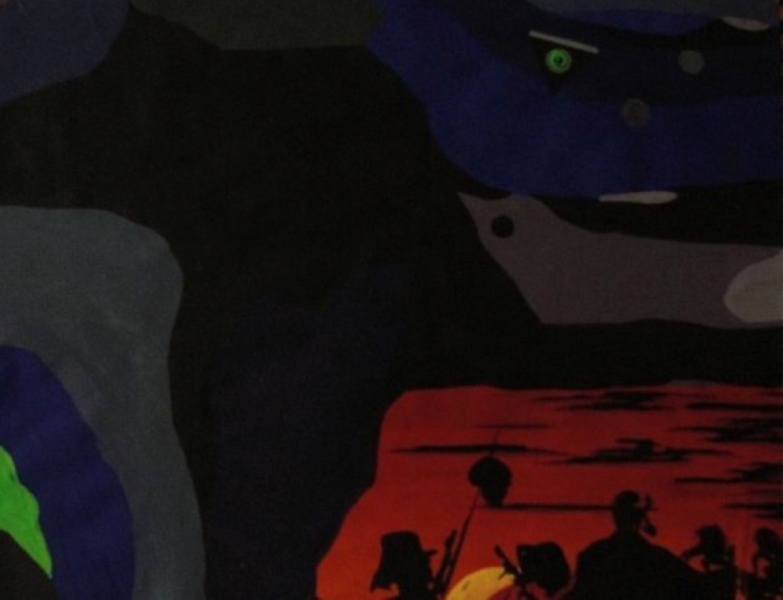 Ivan Pavletic: "Abstract Painting of Regeneration of Life" oil on canvas. 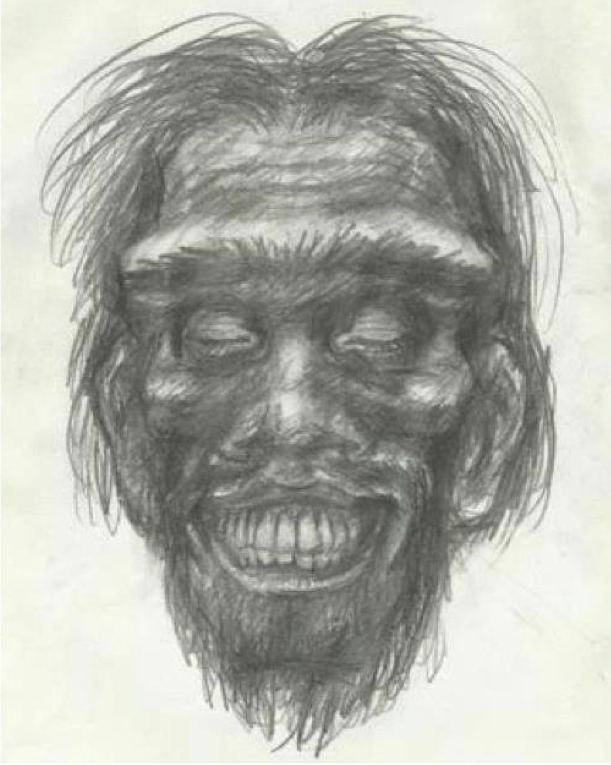 Drawing of a Neanderthal by Ivan Pavletic |
 The Cosmopolitan - a short film by Ivan Pavletic 20. What can you tell us about your other feature films such as "SANE in 1974"? That uncomfortable element of PTSD is something that has been bothering me for some time now. Like an itch that you can't scratch, and that itch was to make a film about the similar instances and experiences among the Vietnam veterans coming back home in the 1970's. Which was an experience that came back home with them, and went way beyond just a War. Somewhat similar to what I went through in Croatia, and then coming to the US some 20 years ago. Nevertheless, the question that comes to mind is, how? How do you make a story about Vietnam veterans in the 1970's? How do you really make a film about an unnecessary war in Vietnam, which was based almost solely on the cold profit of the Military Industrial Complex, which took over 4 million lives. How do you make a movie about such an experience of one generation? Then use this to unfold the story of old friends from the early 1960's Brooklyn, back in the completely changed USA of the 1970's? And put all these elements into one functioning story, with all the necessary bridges, connecting one act to another, binding all the emotional moments into one working story. How the hell does one do all this? Well, it was here where the producer and the co-writer Eddie Portoghese came in and saved the day, by putting these peaces of only a conceptual idea, into an actual working story. I remember in May of 2012, sitting on the Paris Airport, after doing some location scouting for "Tesla: Beyond Imagination", waiting for a plane to Zagreb, Croatia, to continue scouting in Nikola Tesla's birth place of Smiljan. I remember feeling a bit down, as the buildings where Tesla worked were not there any more, or were all changed and completely rebuilt. On top of all that, I couldn't find Jim Morrison's grave that I so wanted to visit, thus I felt disappointed. So as I sat at the airport with my long hair, next to a band of similar Hippie looking guys, I happened to see a reflection of us in one window, and then it dawned on me...1974! We need to make a movie about this. It wasn't until a couple of months later, working on the set of Mark Roeder's (Odoacer in 476 A.D.) award winning production of "The Low Road Baby", that I told about this 1970's Vietnam veterans concept idea to Eddie Portoghese, about domestic terrorist organizations of the mid 1970's, such as the Symbionese Liberation Army, and we started brainstorming further. It was also on that set of "The Low Road Baby", that the beautiful Audrey Walters came aboard, while Eddie came up with the idea of Society Against Nixon Everybody as a possible domestic terrorist organization, hence S.A.N.E. was born. With the cool ring to the name, it stuck as what is known today as "SANE in 1974". However, the full story was still not there yet, as what I had was still only just a story and a conceptual idea, and still far from an actual full story. Also, most likely with the strain of working on the insane undertaking of "476 A.D." plus the stress with the everlasting pre-production of "Tesla: Beyond Imagination", I was caught in a writers block, motionless, without being able to move right or left. It was then that the stunt coordinator from 476 A.D. Eddie Portoghese took over, who probably saw the quicksand I was in, and who also helped me a year before in the impossible circumstances of the battle sequences shoot of "476 A.D.". So Eddie finally helped write the first version based on the ideas we kept on brainstorming about for months. This was the necessary fuel to get me moving again, and get the original concept to fill the story that now had a functioning flow. "SANE in 1974 is something that gives a certain humility, and will humble even the most rock hearted person." We finally had a story ready to shoot, and right away, Eddie and Audrey both jumped in as the producers, making this conceptual idea, into an actual working production. This communication and trust on "SANE in 1974" started to function better and better every day, and with the wonderful talents of Elgin Cahill as a cinematographer on board, everything started working smoothly. Then it came to the talented cast of also Laramie Williams, Benjamin Kroeger, Tom Jankowski, Spencer Kane (Libius Severus in 476 A.D.), Piotr Gzowski (Senator Magnus in 476 A.D.), and many others. Not to mention, the wonderful help of our military advisor Jeff Bosley, Bradley Burrows from 476 A.D. also worked as the electrical department supervisor, David Griesinger as sound, and the wonderful make up by Audra Vandyke. On top of all that, the wonderful musical band from Colorado, "Forests of Azure" wrote a great soundtrack, and some beautiful songs just for this movie, in which you could literally feel the love and passion that fits so perfectly to this story. Everything just started to unfold beautifully. After already seeing such union in the labor of love, on the set of "476 A.D.", it was again unfolding on the set of "SANE in 1974". This is something that gives it a certain humility, and will humble even the most rock hearted person. The fact that I had the opportunity to be a director again, and had the trust of so many talented people, just melted my heart. Most of all, the fact that the father and mother of this production, Eddie Portoghese and Audrey Walters, who really gave the necessary circulation and muscle to this original skeleton of an idea, actually trusted me enough to be the director and give it life. It just gave me the necessary fulfillment I needed. Like a ship that is handed over to a captain to sail, and look over the fate of its crew, becomes more then just work, it becomes a moral obligation towards those who follow you, in order to make something work out of that labor of love invested. This is what makes me proud to have so many talented and capable people around me. Therefore, at the end of 2013, also as for the 50th Anniversary of the Assassination of John F. Kennedy, a man who based his achievement to that love for the people, I wanted to pay my respect, and have the Official Premiere of "SANE in 1974" as a commemoration.
SANE in 1974 - a feature film by Ivan Pavletic "If you have a dream, and that dream has enough of fire to achieve something you really want, it can be done." 21. In film industry, compared to some other professions, which strength would you say is the most important? In film industry, compared to some other professions, it requires a little bit more sacrifice to reach a certain point, you must give a peace of your own self, your own individuality and self security, as well as your own self importance AKA ego, and possibly even the safety of your own financial future, for the purpose of creating something you truly believe in. At the end of the day, there is a lot of humility involved, because you must overcome the natural human element of self-preservation, in order to coup with the fears of uncertainty. I tend to relate my story of "476 A.D.", as well as film making, with my experiences from the war period of my life, because of all those similar elements of uncertainty are involved. When you are putting the strain of entire film production on your shoulder, it requires a lot of energy to overcome such pressure, and such energy can only come if you truly believe in what you are creating, otherwise, you are faced with incertitude, doubt, insecurity, hence instability. There is something very military and battle combat like in true film making, as you just have to be ready for "Murphy's Law", if things can go wrong, things will go wrong, and that's just the way it is, the trick is to be a bit of a mule, horse, ox, a camel, to endure the unendurable, and not break under pressure, So you have to be one on one with this reality, and when you have an entire production on your shoulder, you just can't afford to break from within. Another thing that I'm trying achieve with this production of "476 A.D." is that I'm trying to revolutionize the process of film production, as I believe that since 1980's Hollywood has created a monopoly on film production with making it completely un-affordable for non-Hollywood Indi filmmakers to shoot feature films, independent of Hollywood Studios. By shooting "476 A.D." with DSLR Canon EOS 7D, and the Canon Rebel T2i, as well as the SONY EX1, HDR-FX7, and etc. and might I add that movies like "Black Swan", "127 Hours", "Public Enemies" were all shot on these cameras. I'm trying to show an example and open doors to thousands of dreamer filmmakers who have great original ideas and stories for wonderful feature films to be shot, but are simply shut down by the Hollywood Studio standards that hold the bar for the cost of the big budget productions. I'm trying to achieve something with a very modest and affordable budget, to show fellow filmmakers that it can be done, that you don't need millions of dollars budgets, in fact that you don't even need hundreds of thousands of dollars budgets either. You can get a professional SONY EX1 for under $5,000, a Canon 7D with quality lenses for less then $2,000, or even the basic Canoc Rebel T2i, for less then $800, has the crop factor of a 35mm Motion Picture Camera, thus even just the basic Canon T2i snap and shot camera can shoot you an entire Cinematic non-video looking Feature film. Something that just 5 years ago was still impossible, but obviously times are changing, and there is light on the horizon for passionate INDI filmmakers. If you have a dream, and that dream has enough of fire to achieve something you really want, it can be done. Your abilities are as only limited as your vision is. "I'm trying to achieve something with a very modest and affordable budget, to show fellow filmmakers that it can be done."
SANE in 1974 - trailer
SANE in 1974 - excerpt from the film 22) You are also working on the pre-production of the biography film about one of the greatest scientists that ever lived, Nikola Tesla, by the name of "Tesla: Beyond Imagination", also known as "Tesla: Iznad mašte". What can you tell us about this project? "Tesla: Beyond Imagination", and yes, also known as “Tesla: Iznad mašte" in Croatian, is a biography that I've originally written in Croatian and English, about Nikola Tesla's colorful life, which is now mostly all in English. And yes, he truly was one of, if not the absolutely the greatest scientists that ever lived. The story starts from his childhood in Smiljan, then Gospić, and Karlovac, Croatia, through Prague, Paris, to New York, and Colorado Springs. It shows Tesla's true gigantic contribution to humanity, and how his visions shaped and practically created almost everything that we use in 20th and 21st century. From computers, microwaves, TVs, remote controls, internet, cell phones, as well as text messaging, and many other visions that came out of the brain of this genius. I wanted to use the name Tesla: Beyond Imagination, because I wanted to depict the magnitude of the absolute incredibility that surrounded, and was connected to Nikola Tesla's findings and his life all together. The fact that anything we can imagine, Tesla actually made it possible, showing his extraordinary visions of creating the unimaginable into possible, beyond our furthest imagination. From Tesla's Free Universal Energy for everybody, to such unimaginable far out extremes in Tesla's Space-Time Continuum experiments, such as the unified field based theory, moving instantaneously through space and time, by literally manipulating and folding the space-time continuum AKA teleportation and yes, time travel. Something that in "Tesla. Beyond Imagination" is shown, by also going into great detail of the taboo WW II US Navy Top Secret "Philadelphia Experiment", based perhaps on one of the most controversial of Teslas's studies in the last years of his life. The 1938 Theory of Dynamic Gravity, "conveniently" all abducted by the US Government, immediately after Tesla's death on January 7, 1943. Nine months later, on October 28, 1943. the US Navy Destroyer USS Eldridge literally disappeared from space-time continuum in a flash of blue light, surrounded with electric sparks. Literally vanishing from physical space it occupied in Philadelphia, Pennsylvania, only to appear simultaneously through space and time, in Norfolk, Virginia, some 200 miles away, and some 10 minutes in the future. Then appearing back in Philadelphia with the crew in a total disarray and severe nausea, with some sailors literally embedded in the metal structures of the ship. For 72 years now, ever since October 1943, this "Taboo" experiment/Incident has been proclaimed Top Secret by the US Government in general, and of course, "as usual" denied by the US Navy, as if such experiment never occurred, claiming it to be "impossible, as such claims could not conform to any known physical laws. Up to this day, the infamous Philadelphia Experiment, as well as hundreds of other such Tesla's controversial visions and patents have been hidden from the public. It is with this story of "Tesla: Beyond Imagination" about the real Nikola Tesla, that I wish to bring some of these truths out in the open, after over 70 years of secrecy. With the entire budget plan finalized, and with having Rade Serbedzija confirmed to play Nikola's father, Milutin Tesla, and working on getting Eric Bana to play Nikola him self, the obstacle is only to get the necessary budget to actually start the principal photography some time in the early part of next year. "It is with this story of "Tesla: Beyond Imagination" about the real Nikola Tesla, that I wish to bring some of these truths out in the open, after over 70 years of secrecy."
Promotional poster for Tesla: Beyond Imagination 23) What can you tell us about the next "476 A.D. Chapter Two: The Dawning of the Age of Pisces", the sequel to the first "476 A.D. Chapter One: The Last Light of Aries", as well as the mystique symbolism that 476 A.D. is obviously full of? Well, as the Chapter One: The Last Light of Aries has been out now for over a year, and available for viewing on Amazon.com, as well as Vimeo-On Demand, and other streaming platforms, the work on the much darker sequel "476 A.D. Chapter Two: The Dawning of the Age of Pisces" has been going on since the US premiere of the first chapter in February 2014. With a planned release in 2016. Majority of the Dawning of the Age of Pisces had already been shot by 2014, before the actual premiere of The Last Light of Aries, with many scenes, such as the battle sequences, and the love scenes being shot simultaneously with the first chapter, between 2010-2011, with most of the B-roll and re-shots done later between 2012-2014, and the post-production of hundreds of green screen shots and special effects started from 2014 on. However, because the entire story of 476 A.D. is so very complex, it really has two different dynamics, hence it could really only be delivered in two parts. Like gradually climbing a mountain, Chapter One: The Last Light of Aries, depicts the light more refreshing side of Rome, with a slow gradual incline towards the real peak of the mountain, and culmination of the story. As Chapter One depicts the last fire, or spark of the old Greco-Roman Antiquity AKA the end of Age of Aries, as the last spark of the free state of mind, before its final demise, Chapter Two depicts the more colder side of the story, surrounded with brutal reminders of cruel cold reality of life. 476 A.D. Chapter Two: The Dawning of the Age of Pisces, with the final disastrous Roman defeat by the Germanic Foederati in September 476 A.D. it depicts the more sad reality of the colder night like Medieval times, also known as the Dark Ages, that followed the sunny light and more depth free days of the Roman Antiquity, that ended in 476 A.D. When, the original Savior of Rome, General Flavius Aetius freed the already weakened Roman Empire, from the clutches of Attila the Hun in 451 A.D. it gave Rome the last spark of its once mighty fire and power.
 General Flavius Aetius and son (Ivan and Niko Pavletic)
Ivan and Niko Pavletic at BlissFest Film Festival. For instance, what is seen in the 2000 movie "Gladiator", with the fictitious character of General Maximus, was really based on General Flavius Aetius, some 250 years later. The real "Savior of Rome" who brought Rome its true self back was Flavius Aetius, and a jealous inferiority Napoleon complex based Caesar who had him killed as a political threat, was Valentinian III, in the 450's A.D. not Commodus in 180's A.D. Caesar Commodus was a feared and ruthless tyrant, who ruled Rome with an iron fist for some 15 years, and did not kill his father for the throne, as depicted in the movie "Gladiator". Commodus barely even knew his father Marcus Aurelius, who did not spend much time in Rome at all, and had died from natural causes in the Roman frontier city of Vindobona, ancient Vienna in 180 A.D. while Commodus had already co-ruled in Rome, as a emperor for 3 years before. Also Commodus did not theatrically die in a Roman Colosseum fight with a Roman General, but in fact was strangled in a bath by some wrestler, 12 years after the death of his father. As one of my film school professors once told me, historical accuracy in film does not sell, it is the Hollywood style thatricals that sell. This actually might be true, as films are really an announcement that a story is going on, and not the actual story it self. If you want a real story, read the New York Times, but if you want to be moved and immersed in a story, then read a novel. Just as you will not listen to a favorite song you heard a 100 times, because you are interested in the words it sends, it is because of the warm emotional feeling it brings. Same is with the favorite films, books, or anything you just love. With the second chapter of 476 A.D. I'm trying to fill the cap on the story, that is left with the first chapter at the moment before the final doom that met the last of the Roman Garrison. With the second chapter I also try to fulfill the feel, rather then the story of the Fall of Rome it self. As for years I have carefully researched this period of the late Roman Empire to the best historical accuracy, it is not enough to only depict the actual happenings in the historical chronological order, but depict the entire ambience and atmosphere of how I imagined the late antiquity might have felt like. As nobody can really know for sure how people of the 400's A.D. behaved, or felt like inside, we can really only guess. This is where filmmakers, writers, painters, and other artists, can use their expressionist freedom to depict that very feeling. At the end of the day, it can really be only subjective, so I for one, use a lot of my dreams when I paint, write, film, or edit, hence when I was editing the Chapter One: The Last Light of Aries, through variety of different collages intermixed with various sounds and music, I tried to depict the type of images and feel as a dream, based on, and coming directly from what I dreamt about such times. Like that moment right before you wake up in the morning, when your body is already waking up, but your brain hasn't full waken yet, your subconscience is still semi-submerged in a dream, even though your eyes might have already opened. I believe that such moments are when we are spiritually the strongest, when the bridge between our conscience and subconscience is at the strongest connection. Also when it comes to symbolism and mystique, the very names The Last Light of Aries, and the Dawning of the Age of Pisces, are really based on this element/moment between the conscious and subconscious. The very reason I use astrological constellations of ages, and so many symbolic images of the sun representing musculinity, and moon representing femininity. The fire, the smoke and clouds of the air, the earth, the water. The lion, the wolf, the eagle representing the different elements of the spiritual world. The dusk and dawn, also in film industry known for the best lighting for filming, what we call the "Magic hour". When the leftover light and moments, or memory of the day of one side of the sky are simultaneously being overpowered by the magic of the night from the other. With the story's culmination in Chapter One, reaching the emotional peak of truth between the father and the son, love is a strong symbol, and perhaps the most important subtext in the story of 476 A.D. as the "Fire in the Heart", is a crucial element that follows both chapters in some way or the other. The Fire in Our Hearts emphasizes the eternal life's fire that burns in us forever, without which our souls lack being alive AKA humanity from love and compassion. This sense of the truth through fire is constantly emphasized through both chapters with the imagery of the fire of the Mediterranean warmth, beauty, love and eroticism, intermingled with the sounds of the Mediterranean cicadas singing, harmonized through constant music and soundtrack, that follows every single moment of both movies. As the Chapter One: The Last Light of Aries constantly tries to warm up the audience with the warmth of the Mediterranean atmosphere, this ambience is ruthlessly destroyed in the colder Chapter Two: The Dawning of the Age of Pisces. This is necessary, as in order to feel remorse for a loss of something such as an age or the atmosphere, one must first gain the attachment to such atmosphere, which is attempted in Chapter One, by literally trying to bring that life fire of the true Mediterranean atmosphere of the life and magic of Ancient Rome. A big element of both chapters is also religion, but instead of being a "Christian" movie per se, the emphasize is rather on the political aspect of the Christian church, and it's domination/take over after the Fall of Rome in 476 A.D. This transition of the Antiquity Age of the fire Aries into the water Age of Pisces is accentuated through a rather unexplained and mysterious symbol of meditation/prayer via brushing the finger into an oyster shell. "Your abilities are are only limited as your vision." is.
Ivan Pavletic "Denver Blue Sky" oil on canvas. This mysterious oyster shell talisman, which reoccurs throughout both chapters, represents a symbol of constant cosmic biorhythm, through regeneration, life, death, and birth. The meditational-religious usage of oyster shells is based on the actual real form of ancient Vedic meditation, through rubbing the interior of sea shells as talismans, especially oysters and muscles. A custom that dates thousands of years ago to ancient India, and even further east towards the Pacific, where it might have even originated many thousands of years ago. Although, due to the great historical information loss from the infamous burning of the Library of Alexandria in 48 B.C. little is really known of the ancient religious or spiritual rituals of pagan Antiquity, however, as well as with the Indo-European languages, vast customs and rituals had many connecting points from ancient Europe, all the way to India, hence I used the artistic freedom to depict this ancient Vedic form of meditation, amongst the ancient Romans. As for the dawn and dusk, it is estimated that the natural cycle of life is based on these very moments. It is a fact that the biggest amounts of natural deaths and births on the earth occur right around dawn, when the still left over moments of the night, are about to give way to the dawning or birth of a new day on the horizon. The question to a painter, writer, or a filmmaker really comes to how to actually depict a moment like this? Of course, a photograph can show us how it looks like, just like so many of those posters in our offices with wise sayings below, show such beautiful images. A beautiful wide shot in a film can give us such an image, but how exactly do we depict such psycho-emotional spiritual feeling, where we get the audience or the readers to fully be submurged, or even teleported into such a feeling or an ambience? That I think is the real trick which I have been trying to find hundreds of ways to immerse people into the actual story. It is not enough to simply show, but the audience must be completely immersed, engrossed, and absorbed into the momentum of the film. To me, that is so important, that if I can achieve this with only 20% of the audiences, in my eyes that is a victory. When we get to the bottom of it, it is really difficult to make one movie about the Fall of the Roman Empire, or even two, or three for that matter. It is just such a complex chain of events, that filmically is practically impossible to be told, other then through some abstract alternative form. When we take in consideration that at the height of its power in the 1st and 2nd century A.D. Roman Empire consisted of some 2.2 million square miles, or 5.7 million square kilometers, with a population of some 60 million people.The entire Empire had approximately 50,000 miles, or 80,000 kilometers of roads that spread the Roman civilization in the known world. It took over 800 years for the Ancient Roman civilization to reach its height, and 300 years for it to decline. Some nations did not last as long as it took the Roman Empire to fall. As up to now, the entire 476 A.D. story has been written only in a script format, I feel that it is simply not enough to describe this whole rich period, and it is my wish and plan after I'm done with the conclusion feature of Chapter Two:The Dawning of the Age of Pisces, to transfer it from a script, and rewrite the entire full story of 476 A.D. and the last 25 years of the Fall of the Roman Empire, in a form of a novel of two parts.
Ivan Pavletic: "Colorado Sunset" oil on canvas. |
|
O FILMU Ime filma: 476 A.D. Prvo poglavlje: Zadnje svjetlo ovna Trajanje: 76 minuta
Kratki sinopsis: Nakon pobjede nad Atilom Bičem Božjim, 451 A.D. Rimski general Flavije Aecije, sa svojom politickom snagom postaje prijetnja senatu i rimskom caru Valentiniju III, koji ga daje pogubiti. Nakon toga, rimsko carstvo ulazi u posljednje dvije dekade propasti, sto dovodi i do samoga kraja carstva 476 A.D. O AUTORUIvan Pavletić rođen je 21. ožujka 1974. u Karlovcu. Režiser, slikar, producent i glumac koji je od najmlađih dana pokazivao izraziti talenat za likovno izrazavanje, koje ga je dovelo do škole primjenjenih umjetnosti za slikarstvo u Zagrebu, koju je zavrsio 1993. Istraživački duh u likovnom izražavanju, doveo ga je i do filma, gdje je nastavio školovanje u tom smijeru. Od 1996-1998. Studirao je filmsku umjetnost na Career Education Centru u Caoloradu, a glumu je studirao u školama John Robert Powers i John Casablancas. Od 2008-2013. Nastavio je studij na filmskoj akademiji u Coloradu (Colorado Film School) i Regis Univerzitetu u Coloradu, gdje je završio studij režije i scenarija. Uz režiranje, Ivan je također i glumio u raznim kartkometražnim i dugometražnim filmovima. Makar se je počeo baviti filmom jos od mladih dana, profesionalnu filmsku karijeru započeo je na američkoj produkciji Titus (1999) 20th Century Fox i francusko-američkoj produkciji Le Femme Musketeer (2003) Hallmark Entertainment. Također radio ja na njemačkim televizijskim produkcijama poput Eine Prinzessin zum Verlieben (2005) i Eine Krone für Isabell (2006). Istovremeno, u Hrvatskoj, radeći iza kamere u Jadran filmu, također je glumio kao doktor u prvoj hrvatskoj telenoveli Villa Marija (2004-2005). Osim glume u mnogo kratkometrežnih filmova, napisao je i režirao nekoliko video spotova i kratkometražnih filmova, od kojih su neki završili na američkim festivalima, poput Tough Luck (2009) i The Cosmopolitan (2010). 2010. Kao scenarist, producent, režiser i glumac, započinje produkciju niskobudžetnog cjelovečernjeg filma "476 A.D. Prvo poglavlje: Zadnje svjetlo ovna". Koji je prvi dio sage 476 A.D. od dva poglavlja. Radi se o periodu samog pada zapadnog rimskog carstva između 451.- 476 A.D. Gdje se prikazuje prijelaz iz antike u srednji vijek. Dok drugi dio pod nazivom "476 A.D. Drugo poglavlje: Svitanje ere riba", je u zadnjim stadijima post-produkcije i trebao bi izaci krajem 2014. Istovremeno opet kao scenarist, režiser i glumac, 2012. Ivan je režirao je svoj sljedeći cjelovečernji film "SANE in 1974" koji je imao premijeru 2013. a govori o američkim povratnicima iz Vijetnamskog rata, tokom donošenja ostavke američkog predsjednika RIcharda Nixona, nakon Watergate afere 1974. Ivan trenutno radi na projektu o životu Nikole Tesle, za koji je napisao scenarij. Radi se o biografskom cjelovečernjem filmu o Nikoli Tesli, pod nazivom "Tesla: Iznad mašte", koji je trenutno u pre-produkciji.
Hrvatska premijera '476 A.D. Prvo poglavlje- Zadnje svjetlo Ovna
Isjecak iz filma  24 SATA Express magazin o 476 A.D. 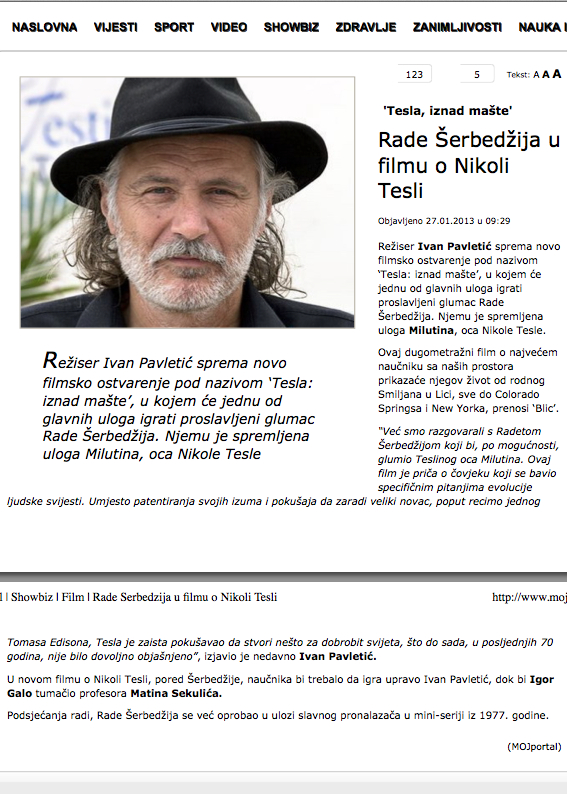 Moj Portal o Tesli - Iznad maste 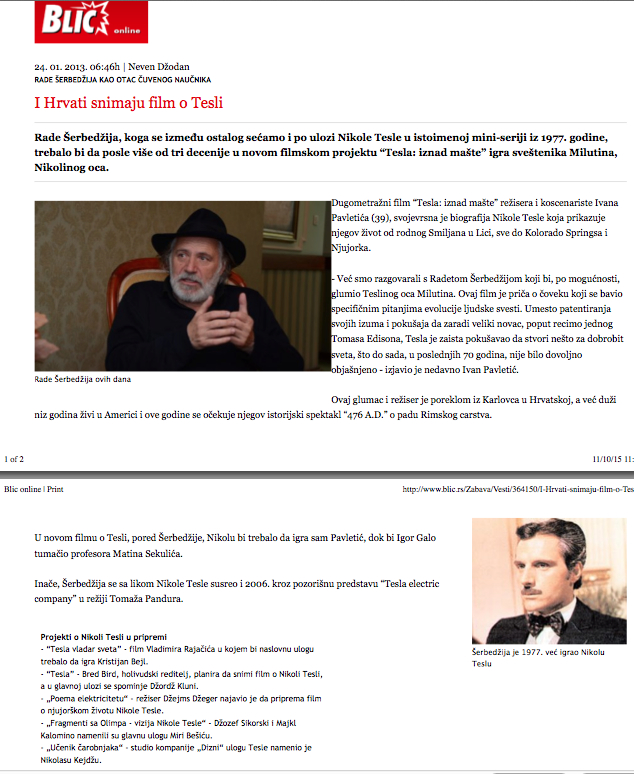 Blic o Tesli- Iznad maste Dokumentarni Film Aleksandar Bosanski Damir iz Bihaća uspio je autostopom obići mnoge zemlje svijeta, među kojima su Maroko, Alžir, Mauritanija, Senegal, Turska, Indija... U videu koji je na YouTube uploadavao američko-hrvatski pisac, reditelj i glumac Ivan Pavletić, Damir objašnjava kako mu je uspjelo da autostopom obiđe sve navedene zemlje.
Izvor: http://www.klix.ba/vijesti/bih/bosanac-autostopom-posjetio-senegal-mauritaniju-indiju/121112104 |
 At the Intendence Film Festival This whole idea started some 20 years ago, one summer night in 1993, during the time of War in Croatia, while laying in the Roman Arena in Pula, Croatia, I was looking at the bright starry sky. Watching all the possible stars and galaxies visible, I started to think that some of them might be hundreds, and even thousands of Iight years away. I realized that I was looking at live images of history happening before my eyes, and I started to find my self in a time vortex. The history was becoming the present, the present was becoming the future, and the future was becoming history. As the whole thought of space time continuum became a relative concept to me, I started to think about things such as the astronomical precession of the equinoxes, different constellation, the future age of Aquarius, the previous 2,000 years of Age of Pisces, and Aries before that. While thinking about the whole different times and ages we lived in, I realized that there were different states of minds that existed before, and that there would also be different states of minds in the future. Perhaps, being sick of the two years of war that I had experienced previously in my hometown of Karlovac, and all the negative energy that had accumulated from it, I needed some kind of a relief, some kind of an escape from the everyday darkness that surrounded my country, my world, and my entire existence at the age of 19. I really started to feel an energy and a connection with the times of the past. The fact that only some 16 centuries earlier, Gladiators fought lions on that same soil, that the Roman Legions, Senators, Caesars, as well as Barbarians, and Odoacer him self walked the same ground, on which I just happened to be laying on, and that is when this whole idea of a story about the end of Rome and Antiquity dawned on me. Interesting that some 20 years later, I shot sequences of 476 A.D. in that same Roman Arena in Pula, Croatia. However, although it seemed as a good idea at the time, it wasn't really until some 15 years later, that I started writing the full script about this idea, and actually preparing for this monumental undertaking, however, little did I know some 4 years ago what magnitude of work I was really getting my self into. Nevertheless, with a lot of passion, a stubborn vision, and lots of help from hundreds of people, this labor of love managed to turn from simply a dream into an actual creation. The love, unity, and film comradery was evident in this production from the very beginning. As Murphy's Law followed, when one option would become impossible, someone always came with another solution, and so forth. From the very beginning, with the ingenuity and craftiness of our cinematographer David Quakenbush, many impossibilities became possible. In all honesty, I would have never imagined that such a huge number of people would actually unite in bringing this dream into a reality, but to my own amazement, it really did happen. "With a lot of passion, a stubborn vision, and lots of help from hundreds of people, this labor of love managed to turn from simply a dream into an actual creation."  The Historic Mayan Theater Premiere of 476 A.D. The unconditional trust of such talented actors as James Russell, Spencer Kane, Heath Heine, Mark Roeder, Dean Satriano, Kirsten Deane, Anthony Cubba, Jason Delancy, Patrick Wolfe, and Luckson Bonhomme, as well as my own little son Niko Pavletic, just gave me the assurance that this story can work. Not to mention the powerful performances by the older Aces such as Piotr Gzowski, and the famous Croatian actor Igor Galo, also gave me the needed assurance that this complex story between the old Age of Antiquity, and the Dark Ages, in fact will work.
It is hard to find words to really thank for this experience, as up to this day, I still believe that there was some deeper energy going on with this production, for so many people were ready to do so much without questioning. I always remember that line from the film, Field of Dreams, "If You Call Them, They Will Come", when I think of hundreds of people from Colorado, and other parts of US, Croatia, and Italy, all those extras, stuntman, grips, and other crews, willing to help for next to nothing, and in many cases fully volunteering for free. So much love and energy, just makes you feel obligated to return something worth while, back to all the people who were there for me. People like Bradley Burrows, who stood there with me for over two years, working with me on all those hundreds of green screen shots, and patiently keying them out. Not to mention talented post-production people like Cristofer Adrian, Matthew Rose, and Shannon Wilkerson. Then Adrianna Veal and her mother Sophia Rose, were as if God had sent them to me when I needed them, who saved me by sewing and creating dozens of 5th century Roman tunics and costumes, as well as full Barbarian outfits. And of course people like Corey Blair, Erik Olson, Eddie Portoghese, Connor Boyle, Zach Holloran, Kevin Wilson, Natalie Johnson, Zak Klecker, Jonathan Fulton, Mary Hatcliff, Stanley Sanchez, Albert Crason, and many many more, without whom this gigantic production would have never seen the light of day. My words can not start to express the gratitude to all the friends who were there for me, and I can only hope that the finished product I return back to you, will be worth all your time and energy. "So much love and energy, just makes you feel obligated to return something worth while, back to all the people who were there for me."
Right after the Mayan Theater Premiere in 2014. |
| Exclusive behind the scenes extras from 476 A.D.!
Final Barbarian Charge
Roman Ballista Catapult created by CGI for rotoscoping. Storyboard gallery The music of 476 A.D.
(C) Artisk, inc. 2015. All Rights Reserved
(C) Artisk, inc. 2015. All Rights Reserved
(C) Artisk, inc. 2015. All Rights Reserved |
